What carnival to attend in Alsace (and surroundings)?
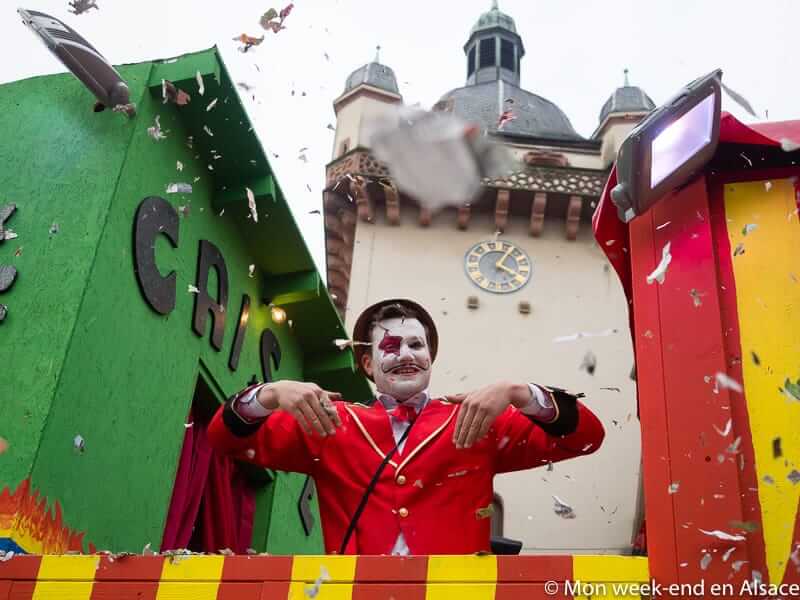
The carnival is a popular festival very rooted in some regions of France. In Alsace, this tradition is particularly present and many carnivals animate the region each year. This is probably due to the proximity of Germany and Switzerland, where the carnival tradition is also important. The carnival in Alsace is sacred! There are many of them, more or less large and of different sizes. Discover our selection of the best carnivals of Alsace and its surroundings not to be missed!
What is the day of the carnival?
Well, that depends! Carnivals usually take place around the time of Mardi Gras, i.e. during the months of February/March.
Carnival of Sélestat – The carnival of the Machores
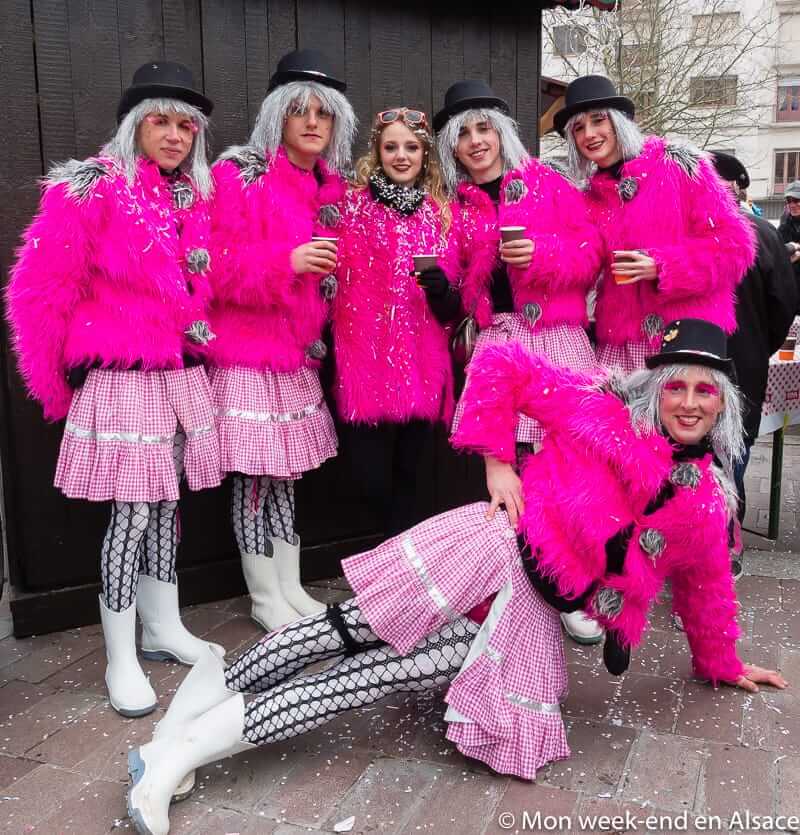
The Carnival of Selestat, called Carnival of the Machores, is one of the great annual events of the city. Of course, I immediately wondered who the “Machores” are, whose strange name does not sound at all Alsatian. The Machores are in fact the organizers of the carnival of Selestat, a troop of merrymakers dressed in colorful outfits, skirts, fishnet stockings and plastic boots… This inevitably leads to other questions: why this outfit and why this name?
So I went to ask them, and it turns out that the Machores were originally butchers from Selestat (yes, yes!) and Machores the nickname given to the head of the workshop (so it’s not at all a deformation of the word majorette, as some say). In the 1970s, butchers wanting to sell their carnival sausages ( Narreklepfer(a speciality sold exclusively during the carnival of Selestat and that I discovered!), disguised themselves as women to walk the streets of the city… And this tradition has remained! The current outfit of the Machores, even if it changes every 2/3 years, still keeps the main elements of this outfit, in memory of this time! Funny, isn’t it?
After this little historical point, let’s come back to the course of the Carnival of Selestat, which is one of the biggest carnivals of Alsace with the carnival of Mulhouse. It lasts a weekend: the party starts on Saturday in the late afternoon with a big night parade, a guggemusik concert (disguised bands, I discovered that at the Basel carnival. Since then I love it!) and a masked ball at the Tanzmatten. On Sunday, there is the great cavalcade (parade) of floats, which lasts about 1h30, then a new concert and animations to finish the day.
I went to the parade and then to the concert and really enjoyed it! First of all, I was quite surprised to see the animation in the streets: the whole city center of Sélestat is in celebration, with many shopkeepers setting up stands outside their stores and a really local and friendly atmosphere. Then, I was impressed by the number of floats (about sixty I think), their creativity and their quality: what a work! The associations go to great lengths during the year to make their floats and costumes, it is really successful.
During the parade, candies are distributed (the children are delighted!) and confetti is thrown (I bet you will find some at home several days later!). There is also a small risk of being knocked down in a wheelbarrow of confetti… I warned you! Anyway, the atmosphere is really nice. A last advice for the road: arrive 15 minutes before to have a good place and cover yourself well warmly, it is cold in February, the parade lasts about 1h30 and we do not want to leave before the end because of frozen toes! 😉
I liked
- Superb parade
- Very friendly atmosphere
- Top for children
- Many spectators but we can see the parade anyway
I liked less
- It’s cold 😛
My pictures of the carnival of Selestat


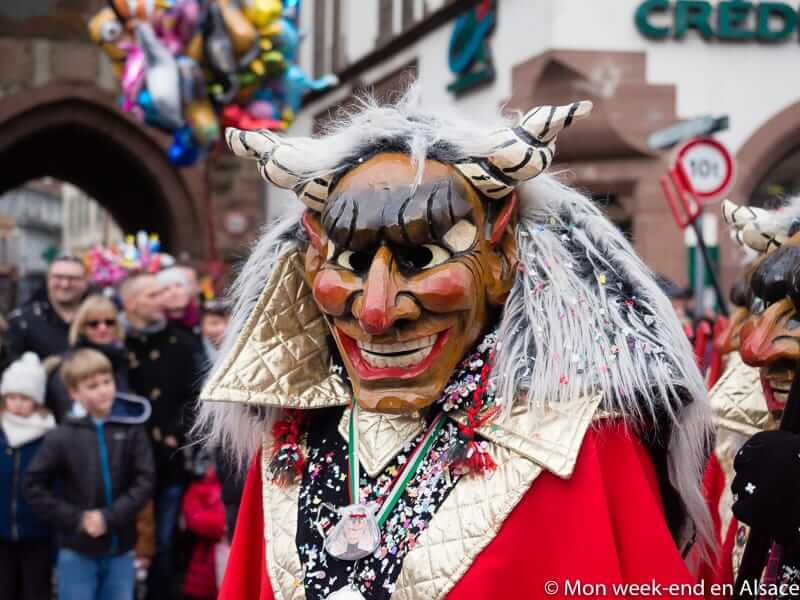

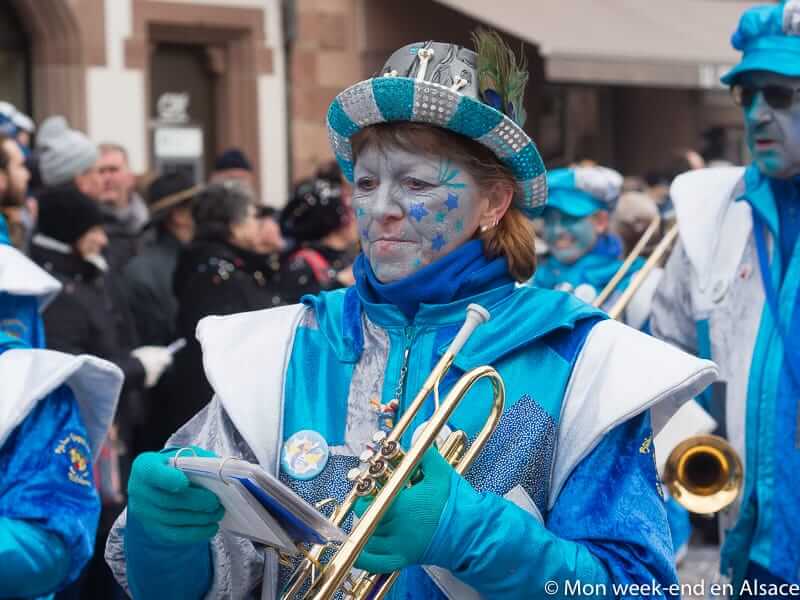
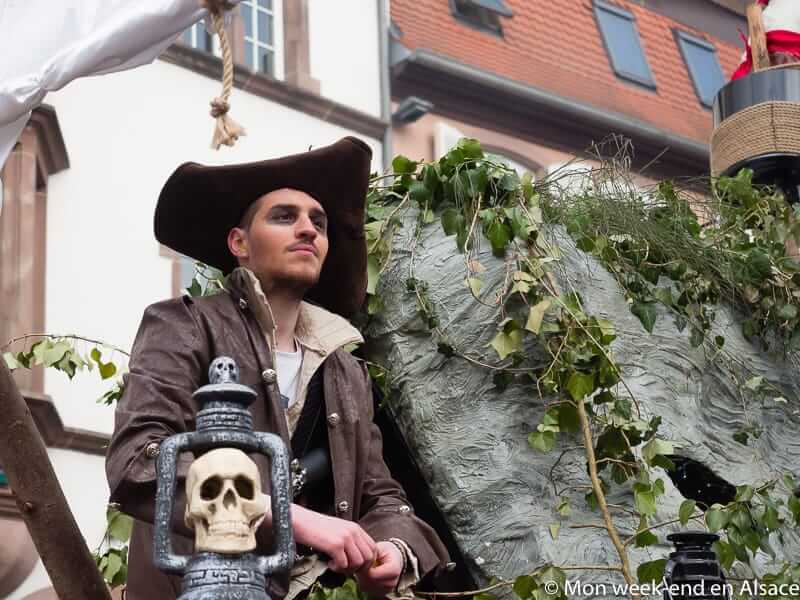
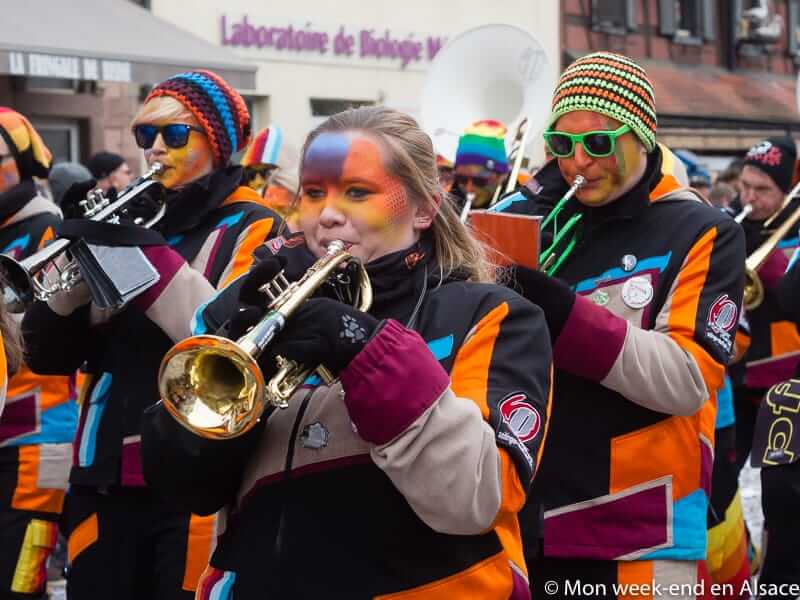
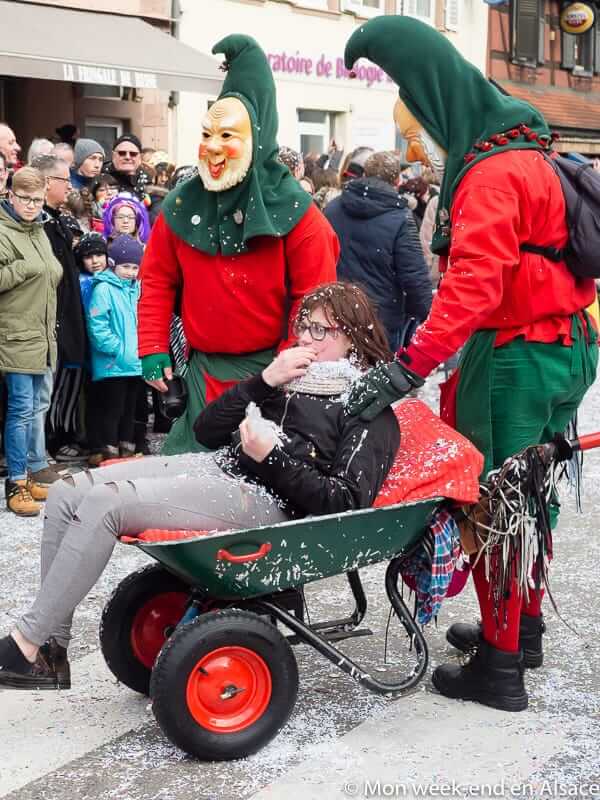
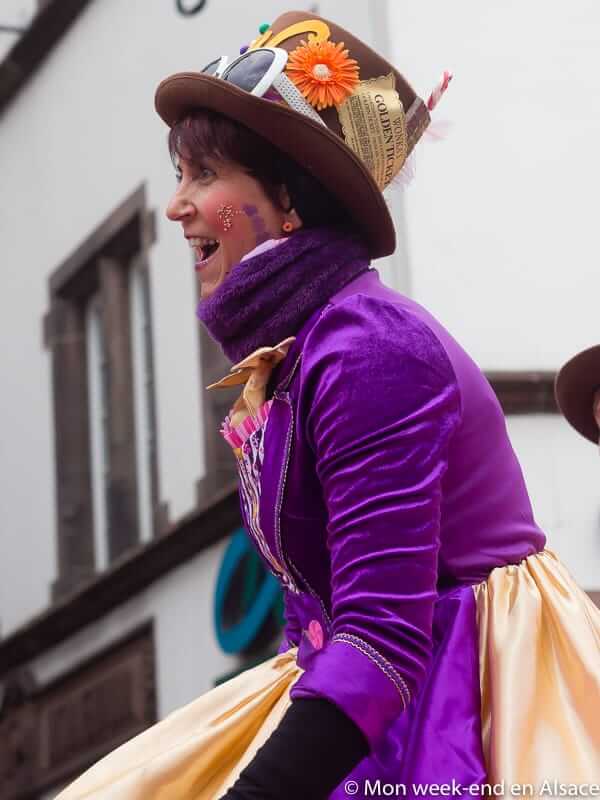
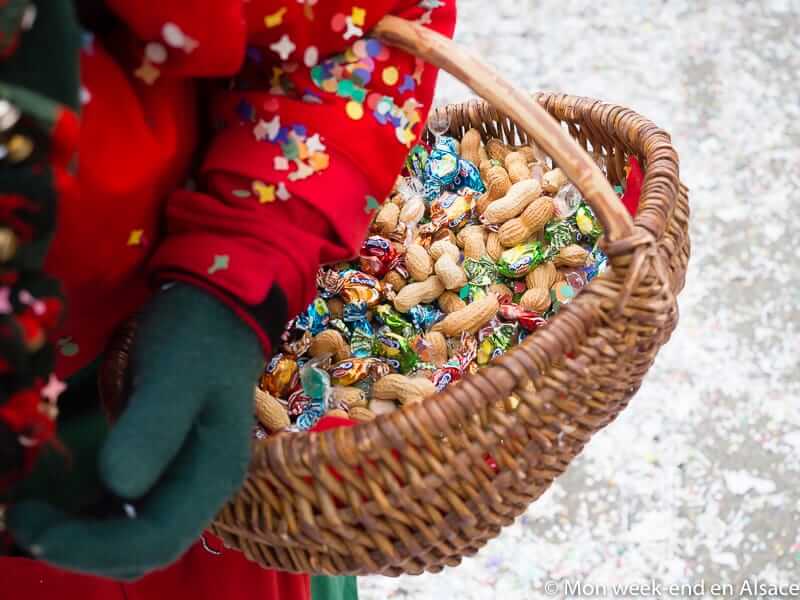
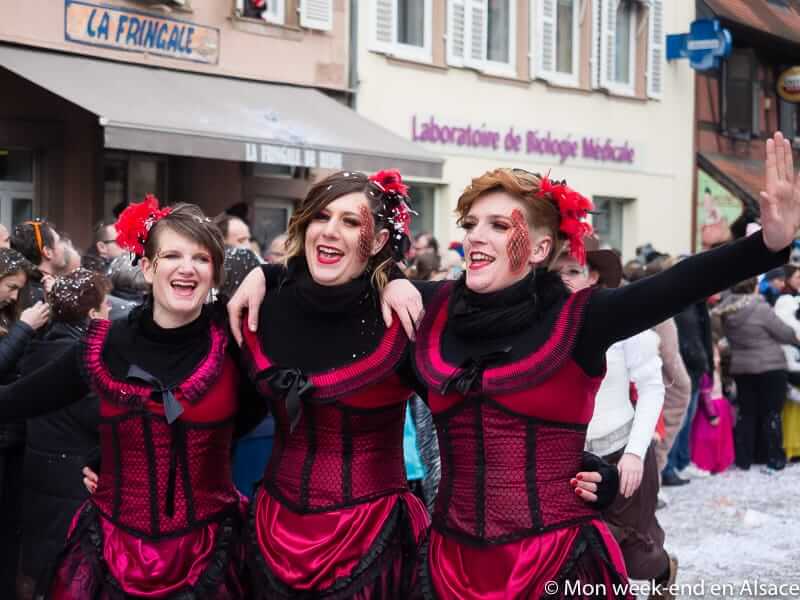
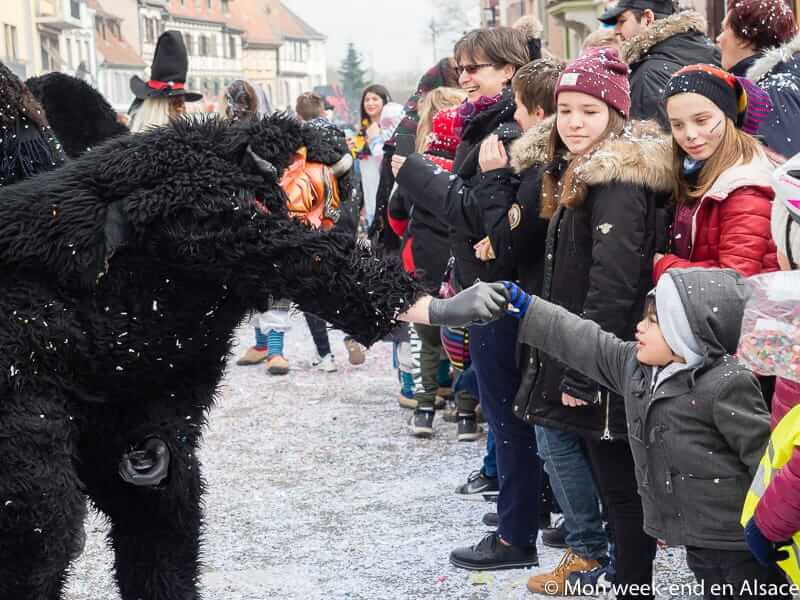
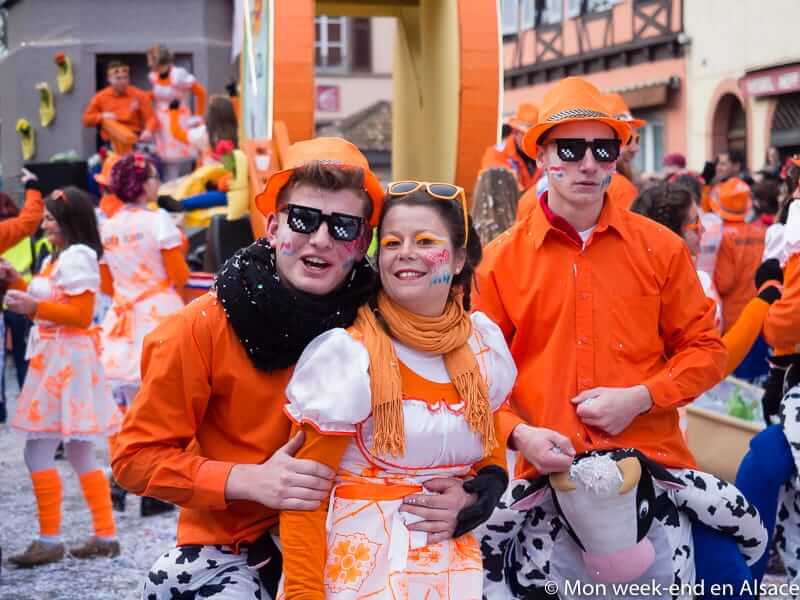
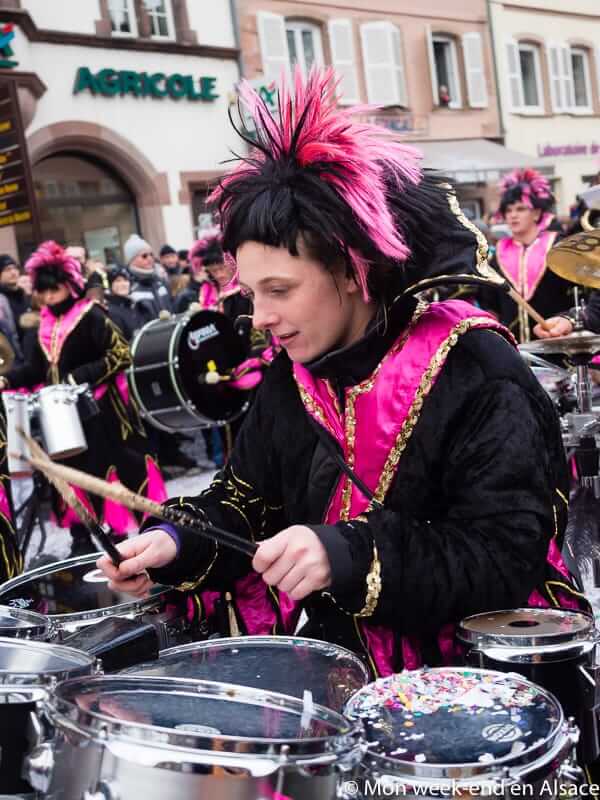

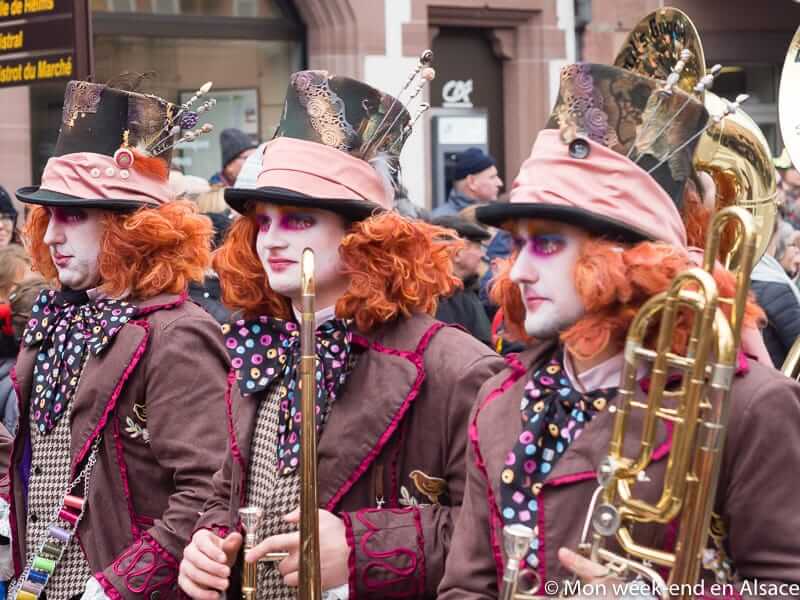
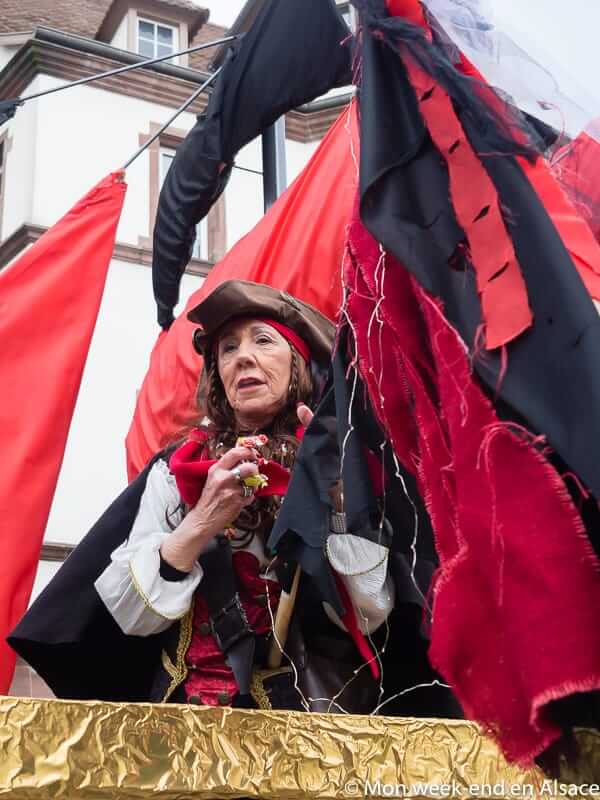
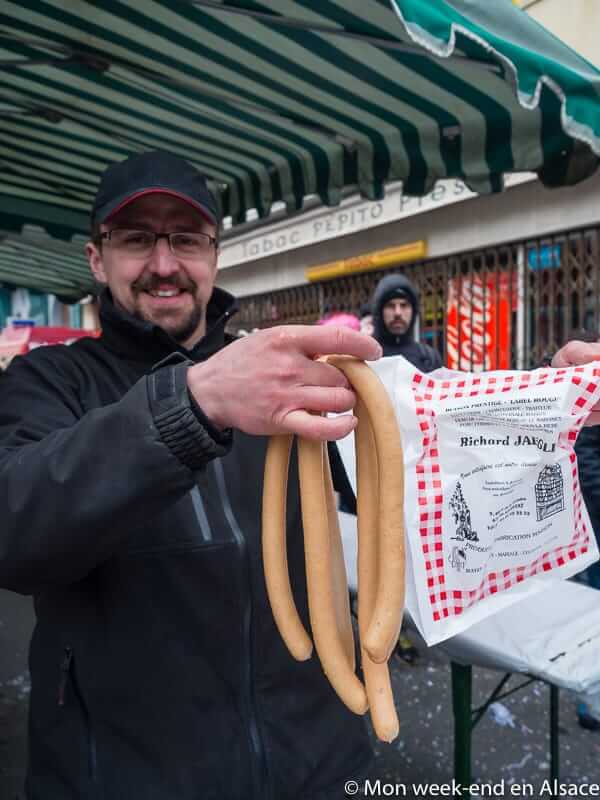
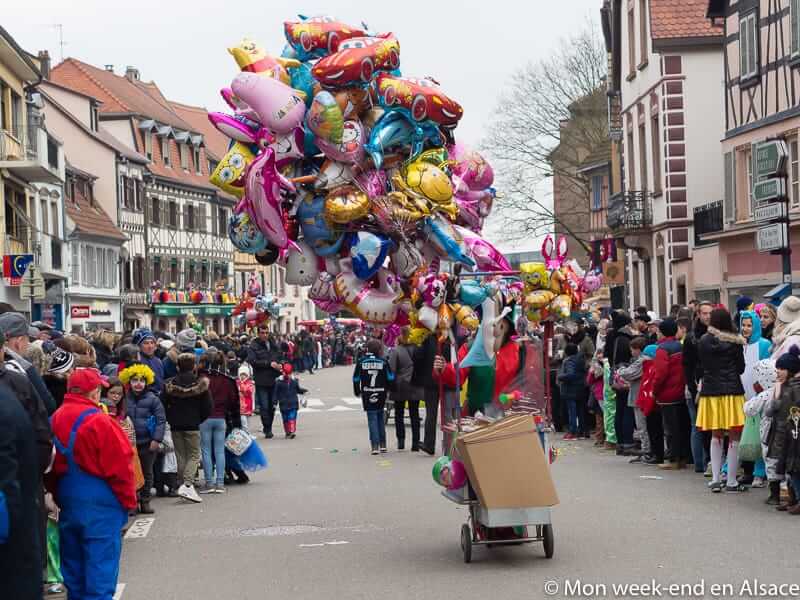
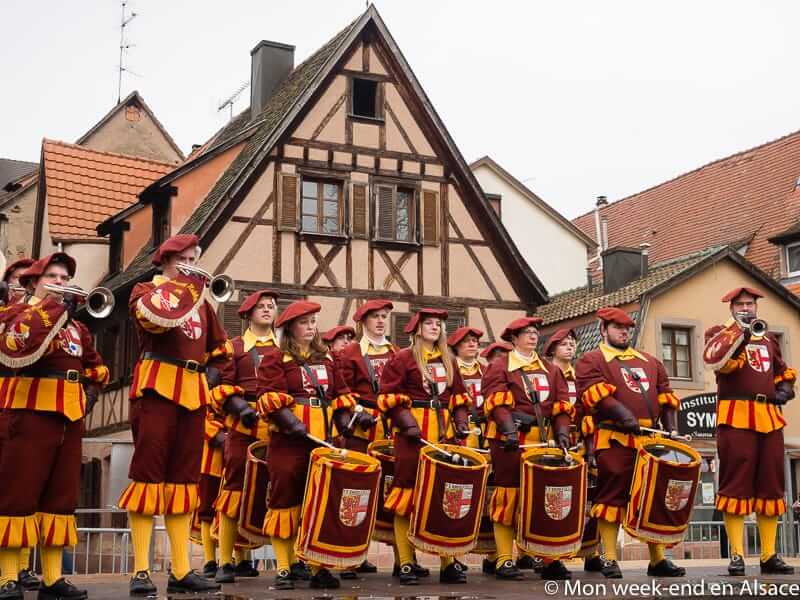

Practical information
Rates
The carnival is free.
Schedules
You will find here the detailed program of the carnival of Selestat.
Access
The carnival takes place in the center of Selestat. For example, you can take Ehm Square as your address. Selestat is located at about:
- 25 km from Colmar (about 25 minutes)
- 50 km from Strasbourg (about 35 minutes)
- 67 km from Mulhouse (about 45 minutes)
Venetian Carnival of Rosheim
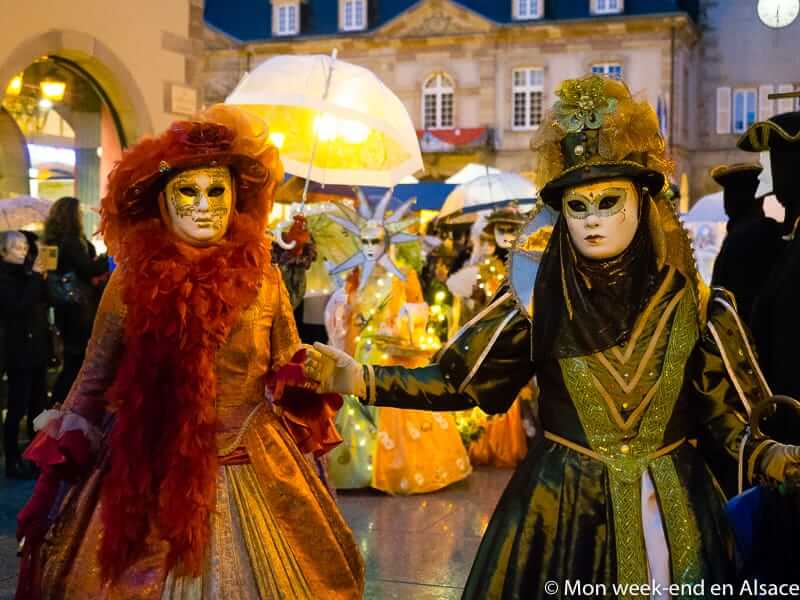
The carnival in Alsace is sacred! There are many of them, more or less large and of different sizes. In Rosheim, a Venetian carnival is organized every year during a weekend.
During the days of Saturday and Sunday, the costumed stroll through the streets of the city. The opportunity for visitors to admire the rich costumes patiently made during the year by these enthusiasts and to take pictures of them. There is also a photo exhibition in the town hall and stands offering objects related to the carnival: if you want to buy a mask, this is the time! Finally, a few small outdoor cottages allow you to taste a pretzel or a carnival donut while having a drink. It’s nice, even if you’ll quickly get around it: it’s really small!
On Saturday evening, a sound and light show takes place in front of the magnificent Romanesque church of Rosheim. I must admit I was a little disappointed because it is not a sound and light show but rather a presentation of the costumes: the costumers parade one by one, with each time a little word about their name and their costume. The whole thing is accompanied by music and spotlights of different colors are projected on the church, but there is no staging that characterizes a show in my opinion. The costumes are beautiful and the scenery superb: you will have a good time if you want to admire the costumes, but you just have to know what to expect! If you can’t get close to the barriers (there are a lot of people!), a screen will still allow you to see the details of the costumes.
Just before the show, try to see the small parade that takes place at the beginning of the village hall: to see all the costumers marching is really beautiful! Be careful, they take a small street just after the town hall to go and gather behind the church, so do not wait for them in the middle of the main street… On the downside, you may not be in a great position for the show afterwards.
I liked
- Beautiful Venetian costumes
- Very nice setting of Rosheim
I liked less
- Show is a bit slow + more a presentation of costumes than a real show
- Very small: don’t plan to spend a whole afternoon there
My photos of the Rosheim carnival
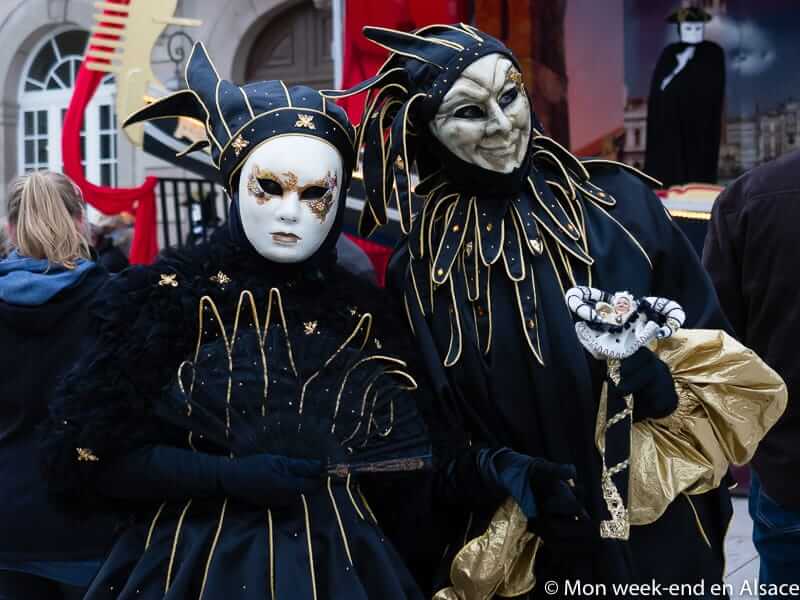
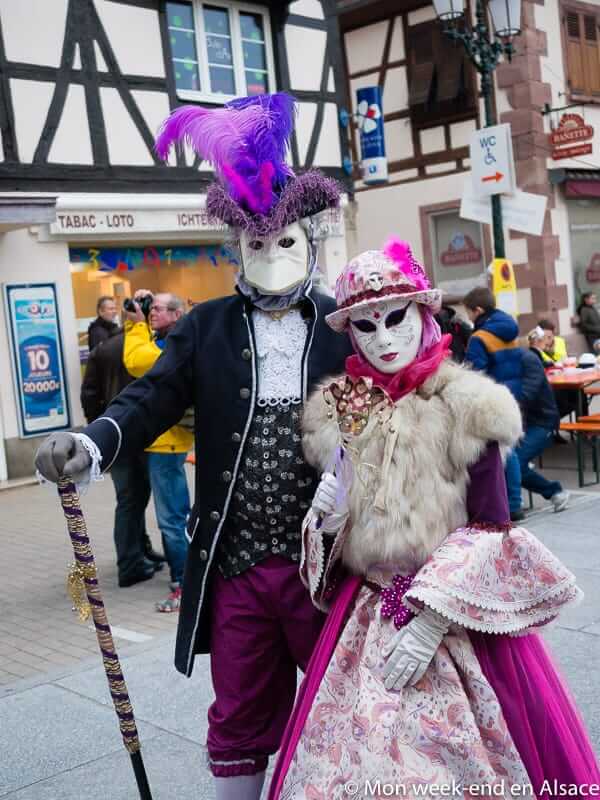
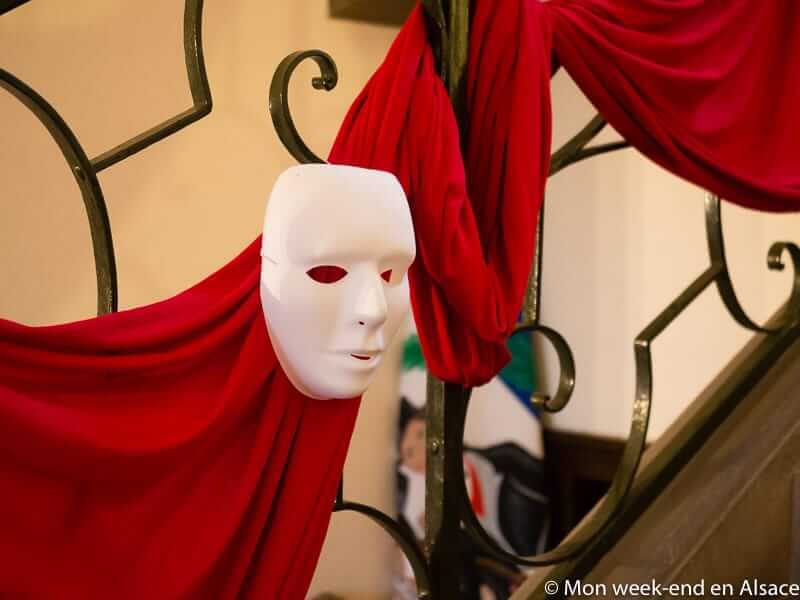
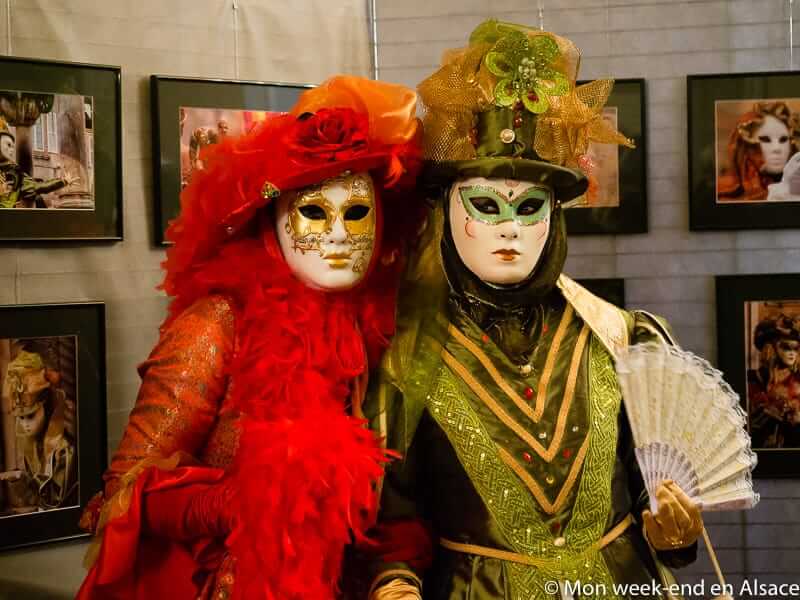

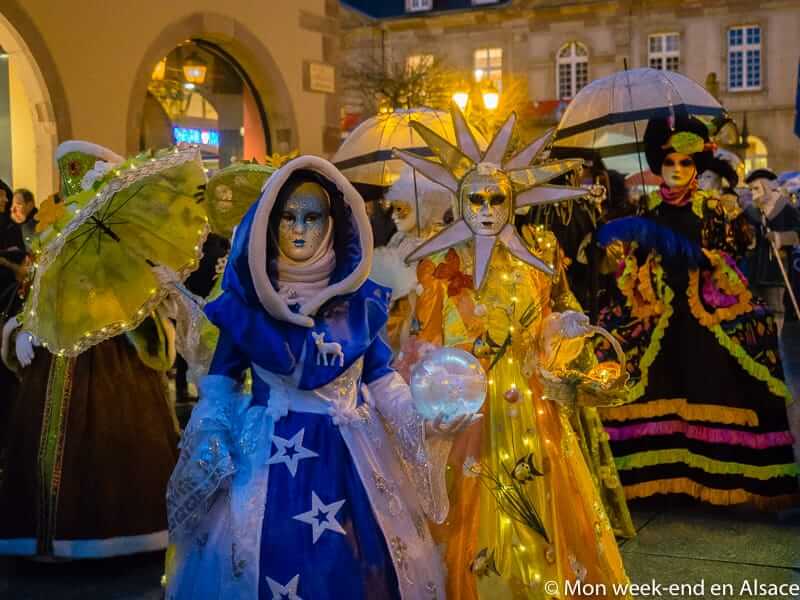
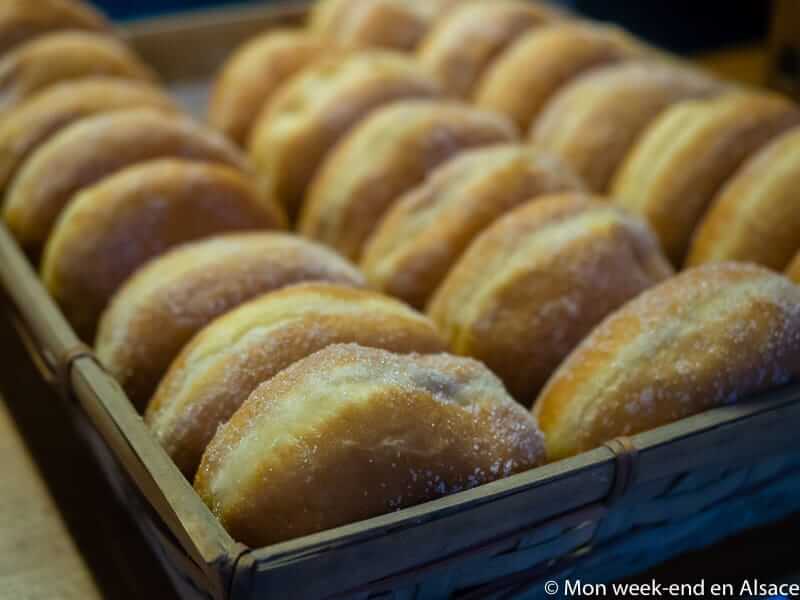
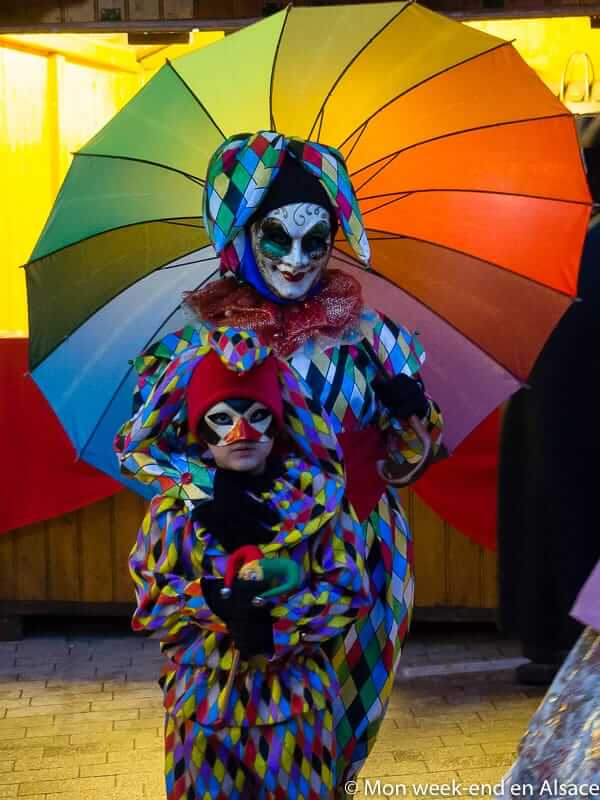

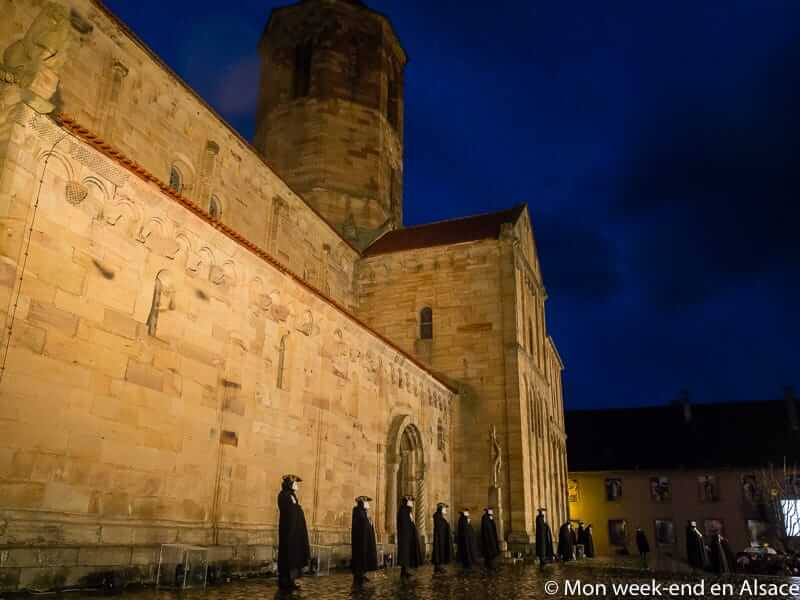
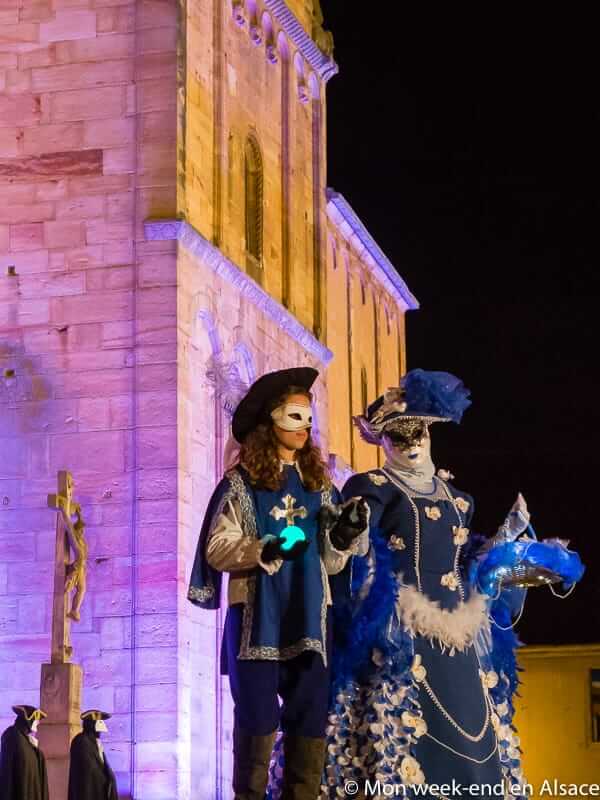

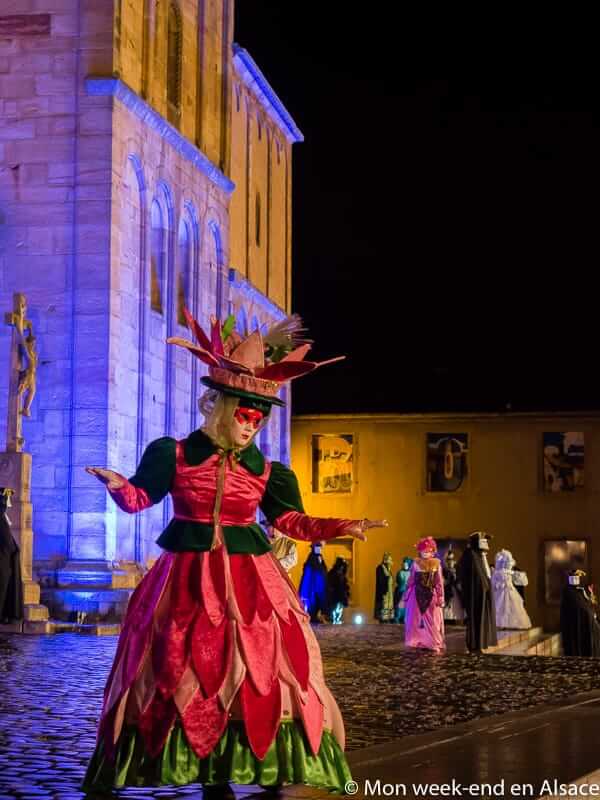


Practical information
Rates
On Saturday, the entrance ticket costs 2€50. It is free on Sundays.
Schedules
You will find here the detailed program of the Rosheim carnival.
Access
By car
The carnival takes place in the center of Rosheim. Parking lots are provided and marked at the entrance to the city.By public transport
You can look at the Fluo website.Carnival of Mulhouse
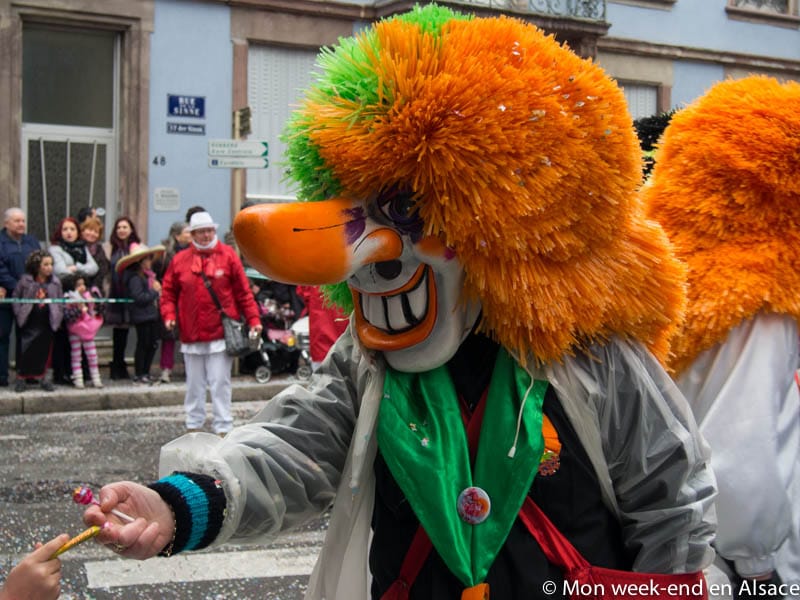
The Mulhouse carnival is one of the great carnivals of Alsace. It is spread over 3 days: handing over of the keys of the city (symbol marking the opening of the carnival) and ball on the 1st day, then children’s carnival on the 2nd day and finally international cavalcade and final carnival on the 3rd day. For the uninitiated, the cavalcade is the great carnival parade and the charivari a kind of popular ball. The international cavalcade, welcoming groups from the region but also from other countries, is really the highlight of the carnival. It takes place on Sunday afternoon and lasts about 1h30. Don’t forget to wrap up warm: it’s a bit cold in Alsace in February 😉
To attend the Mulhouse carnival parade, you don’t need to be dressed up: only the participants of the carnival and the children are, not the adults. You just have to find a place without too much crowd at the edge of the course to settle down and watch the parade. This one is composed of various groups: music groups (called guggas), waggis (traditional figure which one finds with the carnivals of Basle and Mulhouse, which is a caricature of the Alsatian peasant), majorettes… And of course large decorated floats. The children are delighted as many candies are thrown to them in addition to confetti. They will leave with their pockets full (of candy, they are covered in confetti, and so are you!). I thought it was a beautiful parade. Not as impressive as the one at the Basel carnival, which is really high quality, but still very nice!
I liked
- Beautiful, lively and colorful parade
- A great time for the kids
- Many spectators but not a huge crowd either: we can see the show
I liked less
- It’s cold in February to stand still and watch a parade!
My photos of the Mulhouse carnival
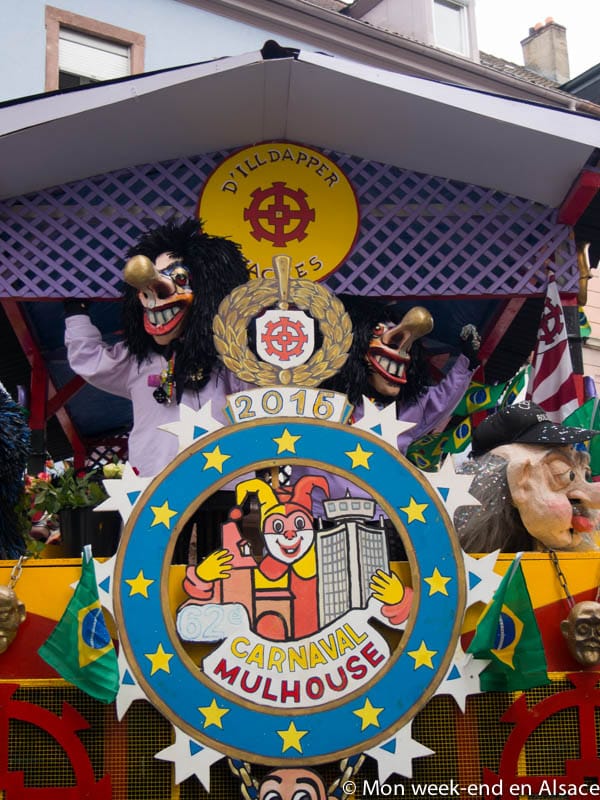
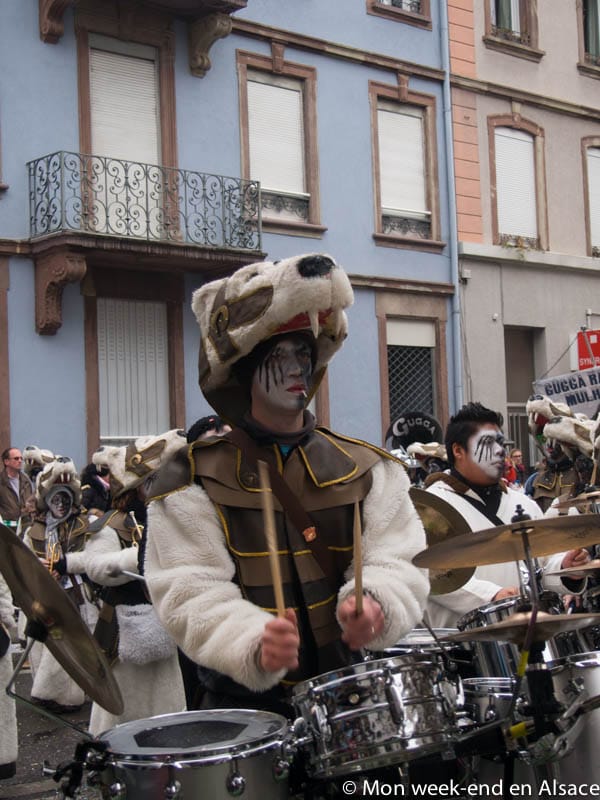

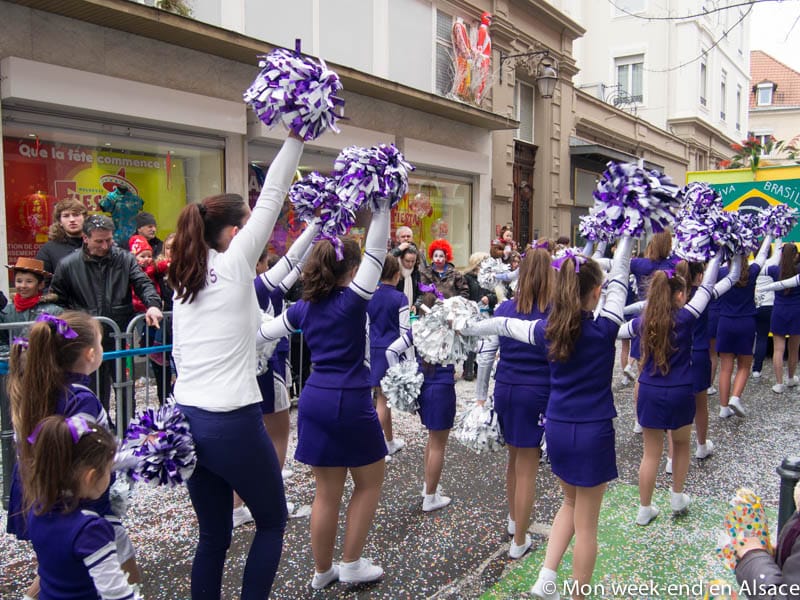

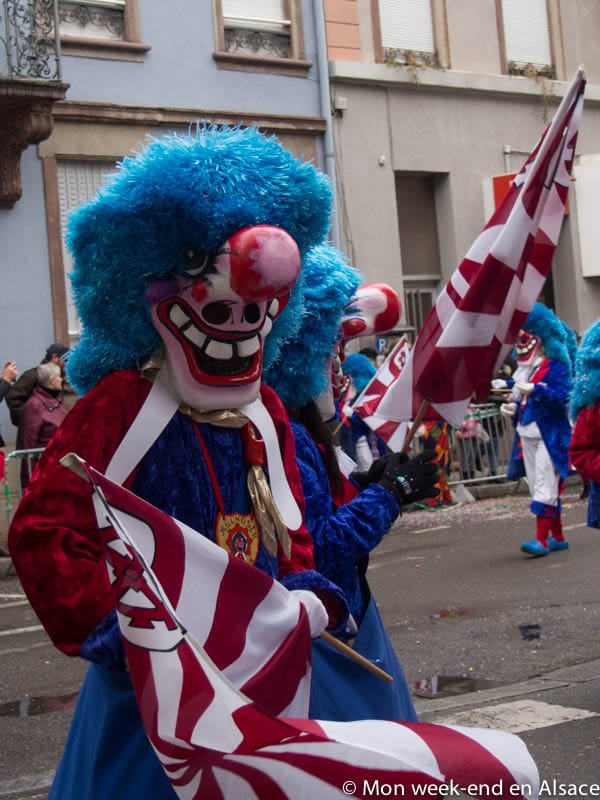
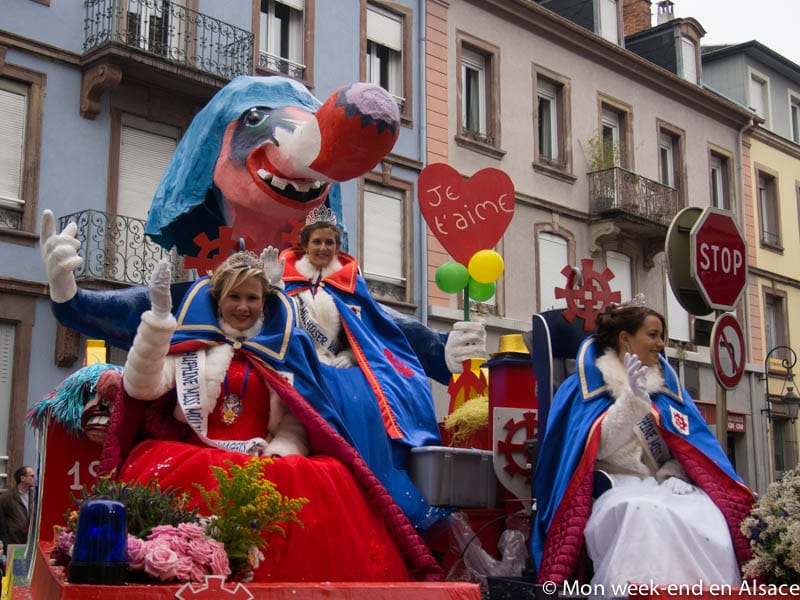
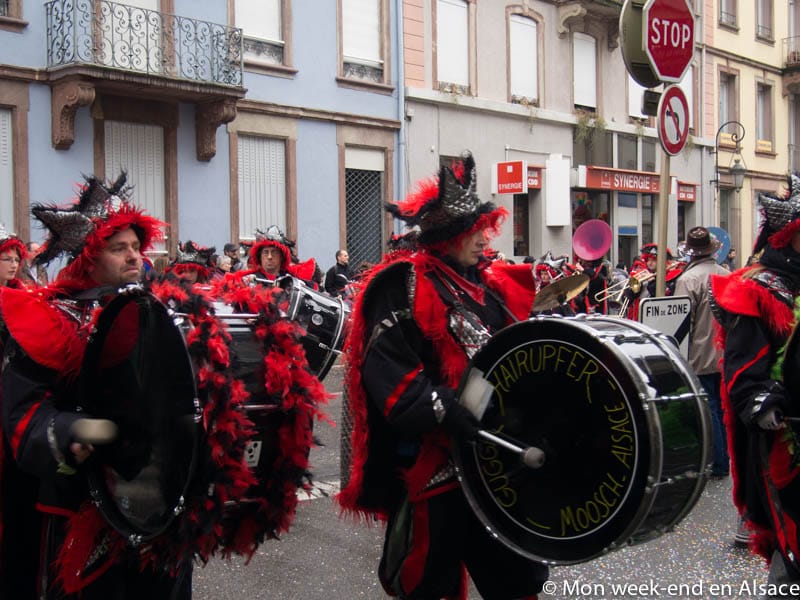
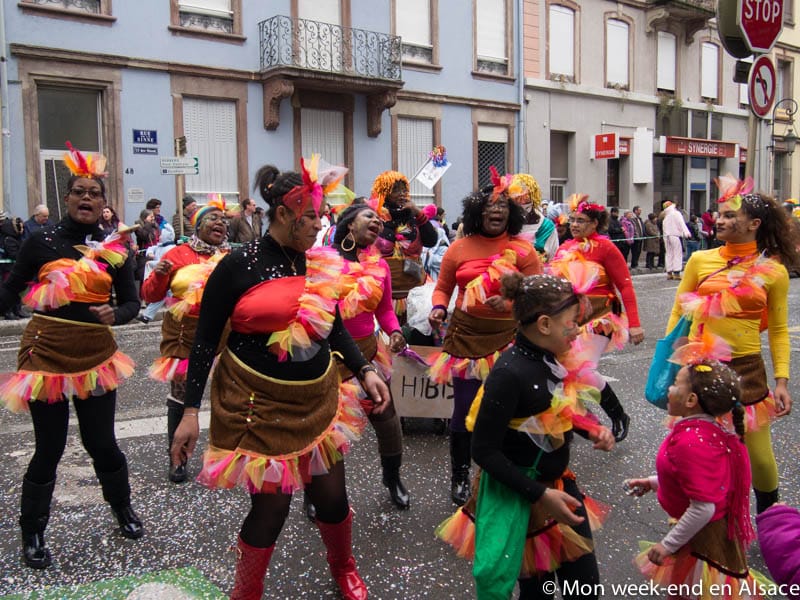
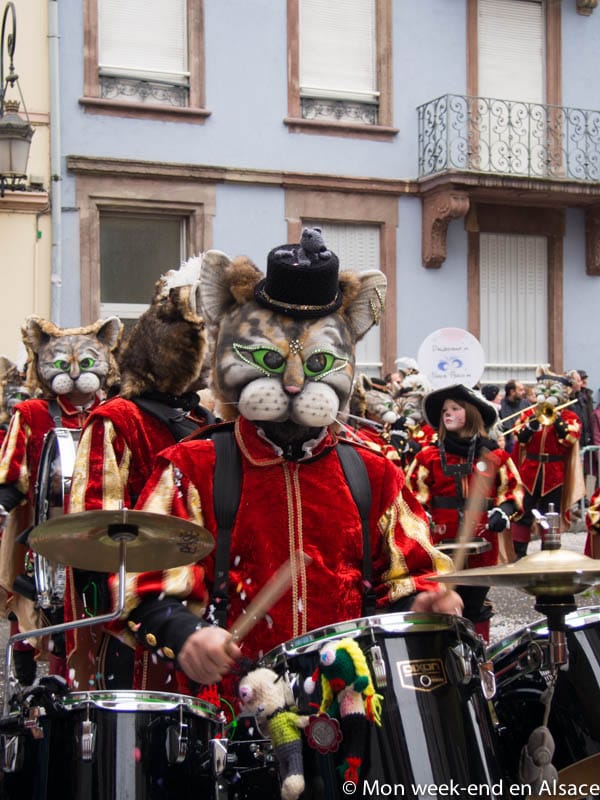
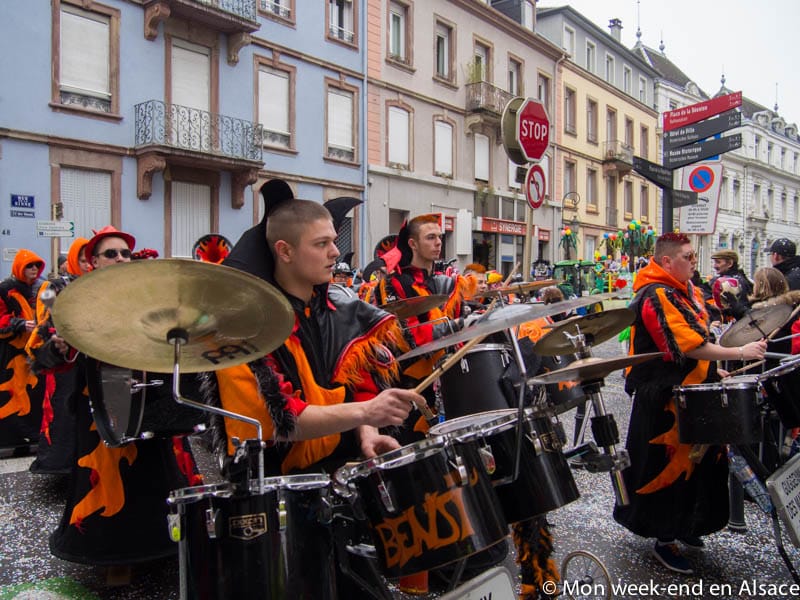
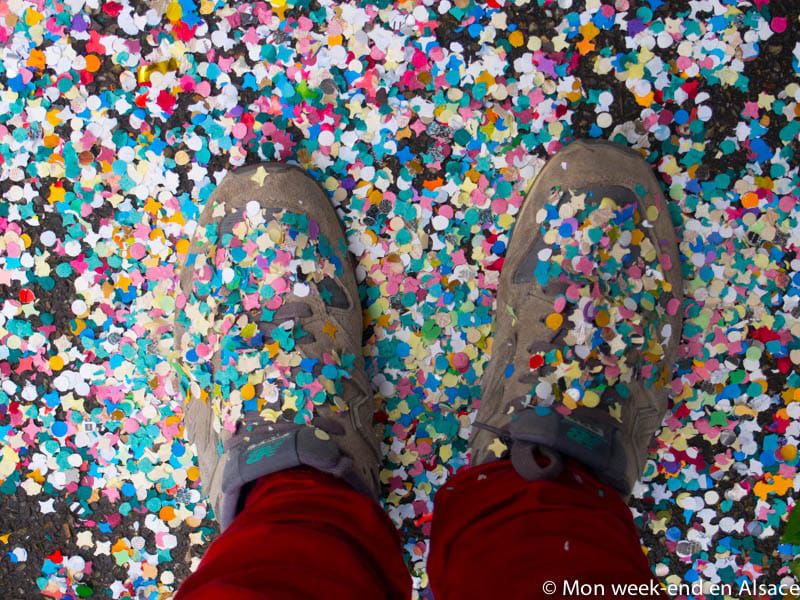
Practical information
Rates
The carnival is free.
Schedules
You will find here the detailed program of the carnival of Mulhouse.
Access
The carnival takes place in the center of Mulhouse. For example, you can take the Place de la Réunion in Mulhouse as your address.
Basel Carnival (Basel, Switzerland)
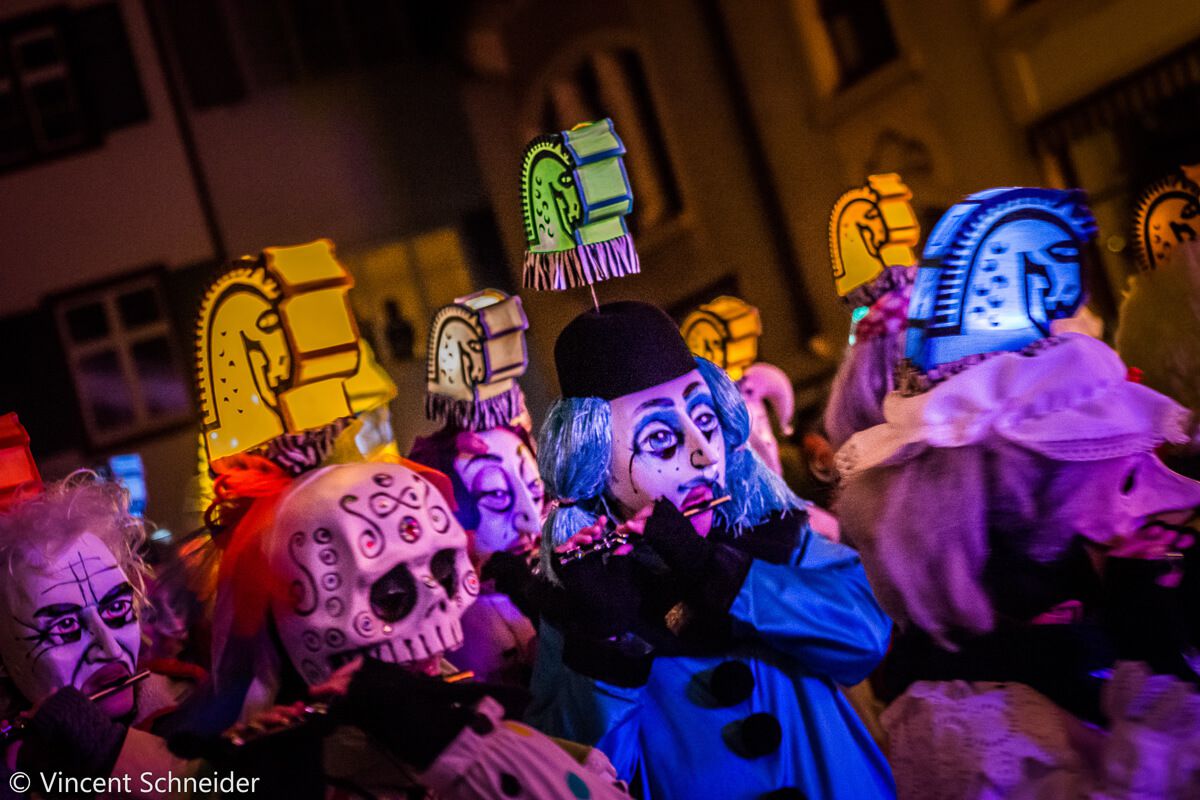
Let’s cross the Alsatian border to the city of Basel in Switzerland. The BaselFasnacht is very famous: it is the biggest in Switzerland. To the sound of the Gugge-musiken (brass bands), the city comes alive for 3 days starting on the Monday following Ash Wednesday (in February or March depending on the year). In Basel, these three days are public holidays, so that everyone can enjoy them.
The famous Morgenstreich
One of the highlights of the Basel carnival is the Morgenstreich, a parade that takes place at the opening of the festivities, that is to say…at 4am on Monday! The atmosphere is really special: the lights of the city are all turned off, highlighting the lanterns and masks of the cliques (groups participating in the carnival). Only the sound of fife and drums resounds in the night, giving the parade a unique (and sometimes a little scary!) atmosphere. After the parade, it is traditional to go taste a flour soup and continue the party in the bars of the city.
Read here the story of Vincent, who lived this extraordinary experience:
1h30, the alarm clock rings. Ouch, it stings but there is a good reason: the Morgenstreich of the Basel Carnival! After a few quick preparations, we headed to the train station for an ultra-early departure: 2h21! In spite of the schedule and the people present in the train, the journey remains pleasant (it is necessary to say that the atmosphere of the carnival already starts to be felt).
The arrival in Basel station is an unforgettable moment: a human tide poured by the various trains on the platform heads towards the station exits to cross the city on foot, in a noisy and silent hubbub. The most surprising thing is that it’s just after 3am!
You don’t have to wait long because the Morgenstreich (lantern parade) starts at 4 o’clock sharp! We take two minutes to buy the Plakette (pinned badge to wear to show your support for the demonstration – several levels of support from copper to gold for amounts ranging from 10 to 100 euros) then head for the city center. Don’t know where to go? No problem, follow the crowd! The parade is very extensive and many places allow to attend the procession and not to miss “a bite”. Once posted, adjustments of your camera are necessary to compensate for the lack of light (indeed the flashes and other lights are not allowed on the parade, it would spoil the show)
All the lights in the city are switched off and Basel is immersed in a unique atmosphere. We begin to hear in the distance the sound of the drums and the fifes of the various “cliques” which cross the city. Appreciate this moment at its true value (despite the lack of sleep): the dark alleys lit by lanterns (some can be considered as works of art), the colorful costumes and masks, the sound of fifes and tambourines: the Morgenstreich is a rare sight of which one must savor every moment.
After a few minutes of strolling through the streets of the city, the people of Basel meet in the cafés to warm up with a drink, a flour soup or an onion and cheese pie. It is theeffervescence in the bistros of the city and this for our greatest pleasure.
No time to savor for my part since my train leaves soon after 6 am. Unlike most Basel people, I didn’t take time off today and I’m starting to regret it. What I don’t regret, however, is having been able to enjoy this magical atmosphere only a few dozen kilometers from home. I’ll be back, for sure, and I’ll make sure I have a little more time on my hands.
Carnival processions
Another highlight of the Basel carnival is the procession that takes place on Monday and Wednesday afternoons. It is really impressive! I found the floats, the traditional carnival masks (especially the waggis caricaturing Alsatian peasants) and the costume work fascinating. Carnival is a serious business here, you can see that there is a lot of work behind it. Don’t come in disguise, it’s not done in Basel at all! Only the members of the cliques are dressed up and participate in the parade. Cliques choose a theme based on local, national or international events of the year. Not always easy to understand these references for foreigners!
During the procession, the cliques throw confetti, candy and fruit. I heard that it was better to have bought a plaquette (a small pin sold for the benefit of the carnival, which can be found everywhere) to receive candy than to be bombarded with confetti! As for me, I had no problems with my bronze badge (the cheapest one) and was happy to support this beautiful tradition a little.
I liked
- Great quality and colors of the floats, lanterns and costumes
- The Morgenstreich is a unique moment, to be done at least once in a lifetime!
- Carnival is a very strong tradition: no Basel citizen would miss it!
I liked less
- Impossible to actively participate in the carnival, or even to understand everything!
- the very early wake up to attend the morgenstreich 😛
Our pictures of the Basel carnival
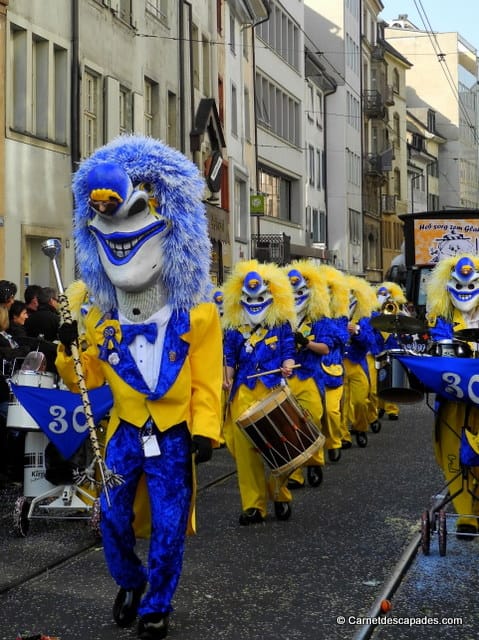
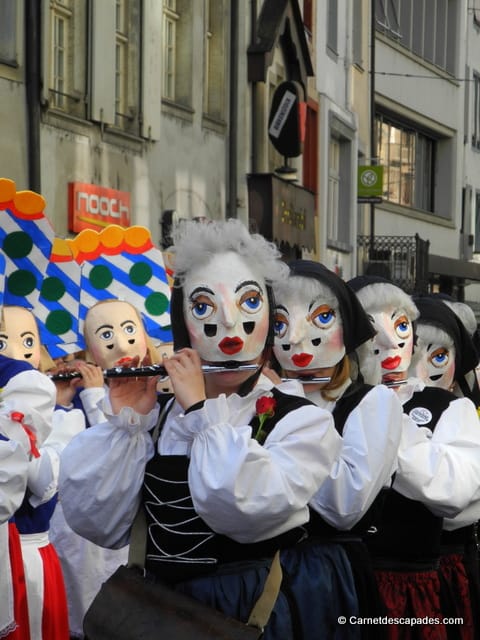

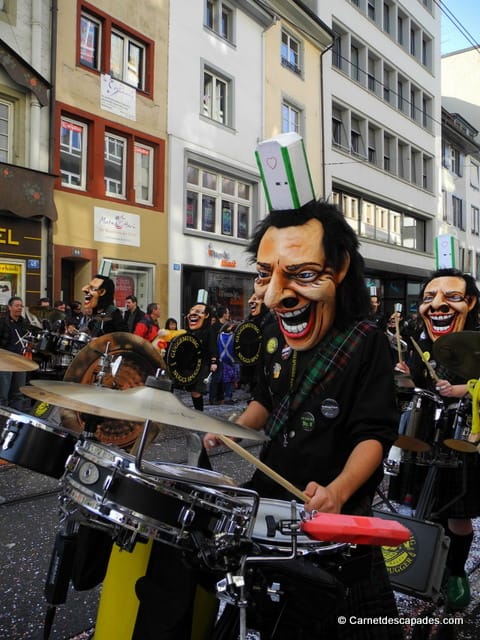
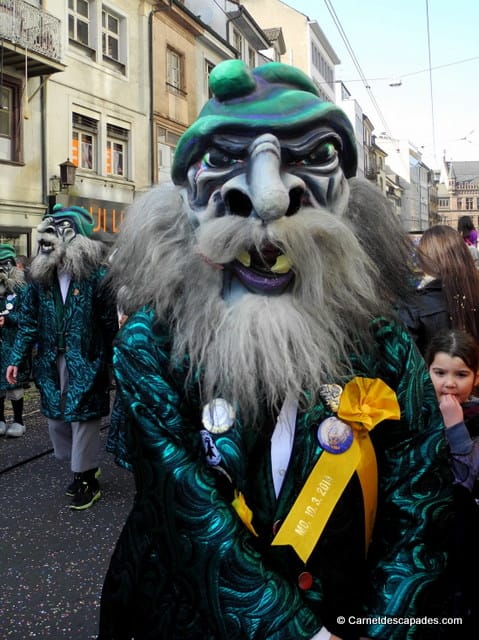
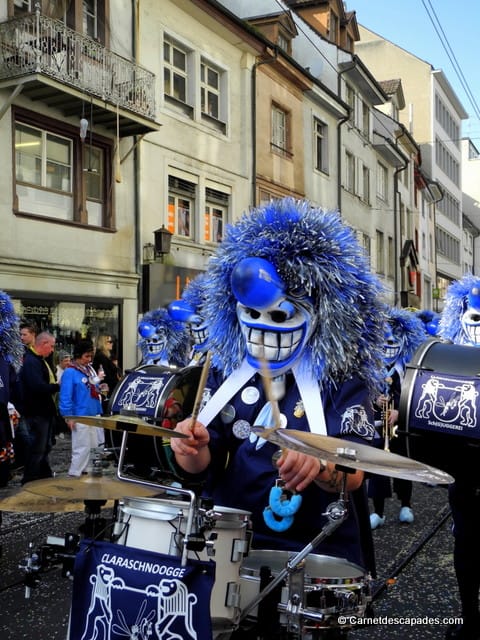

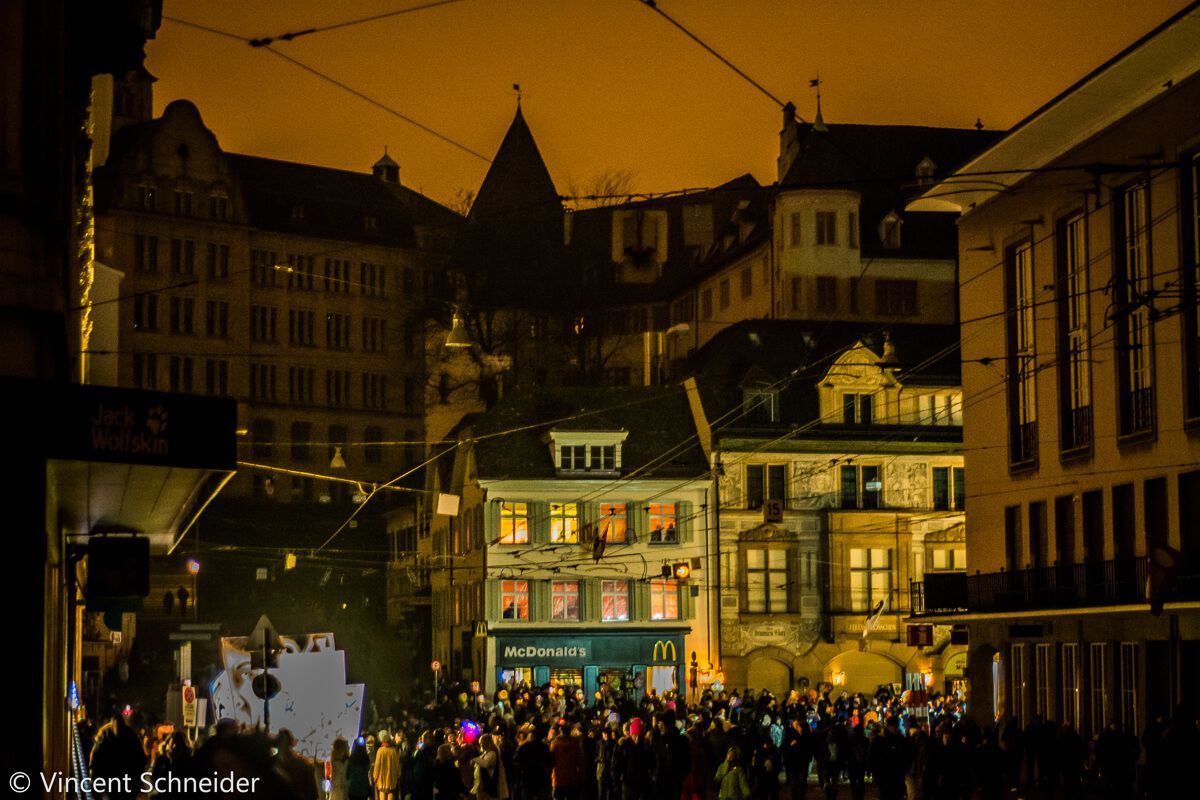
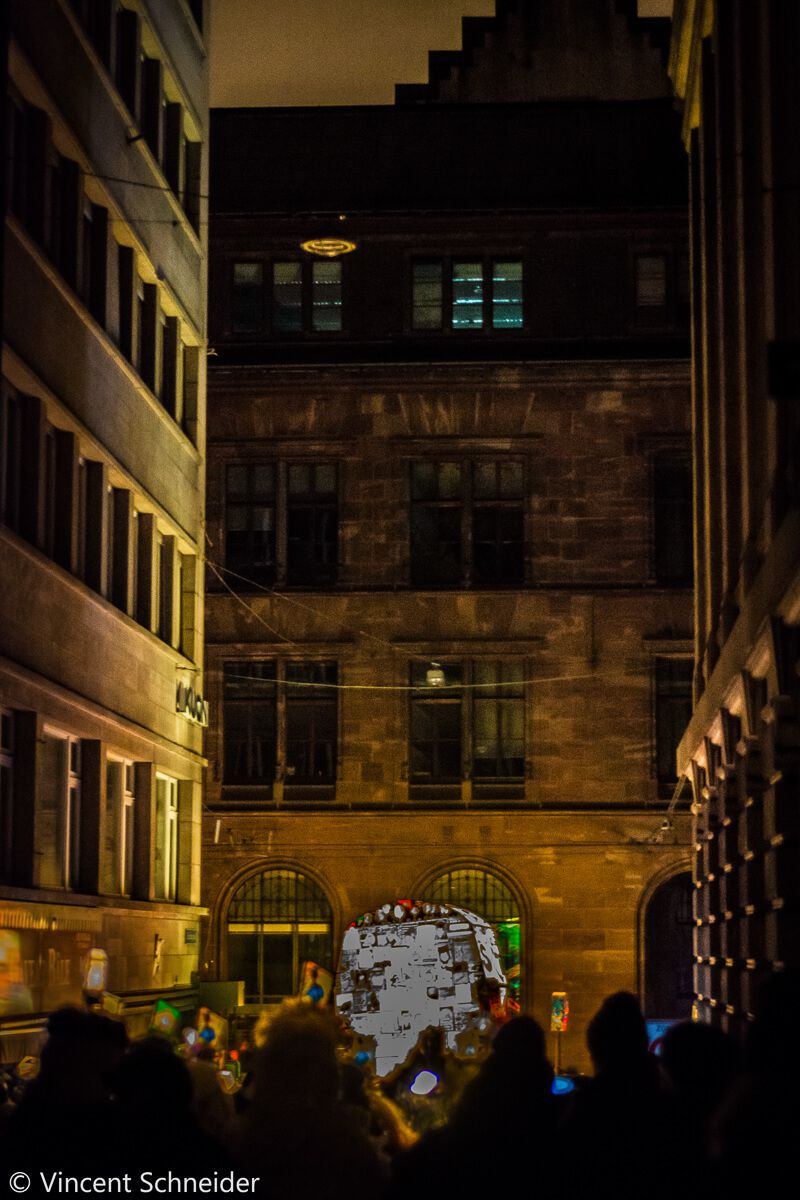
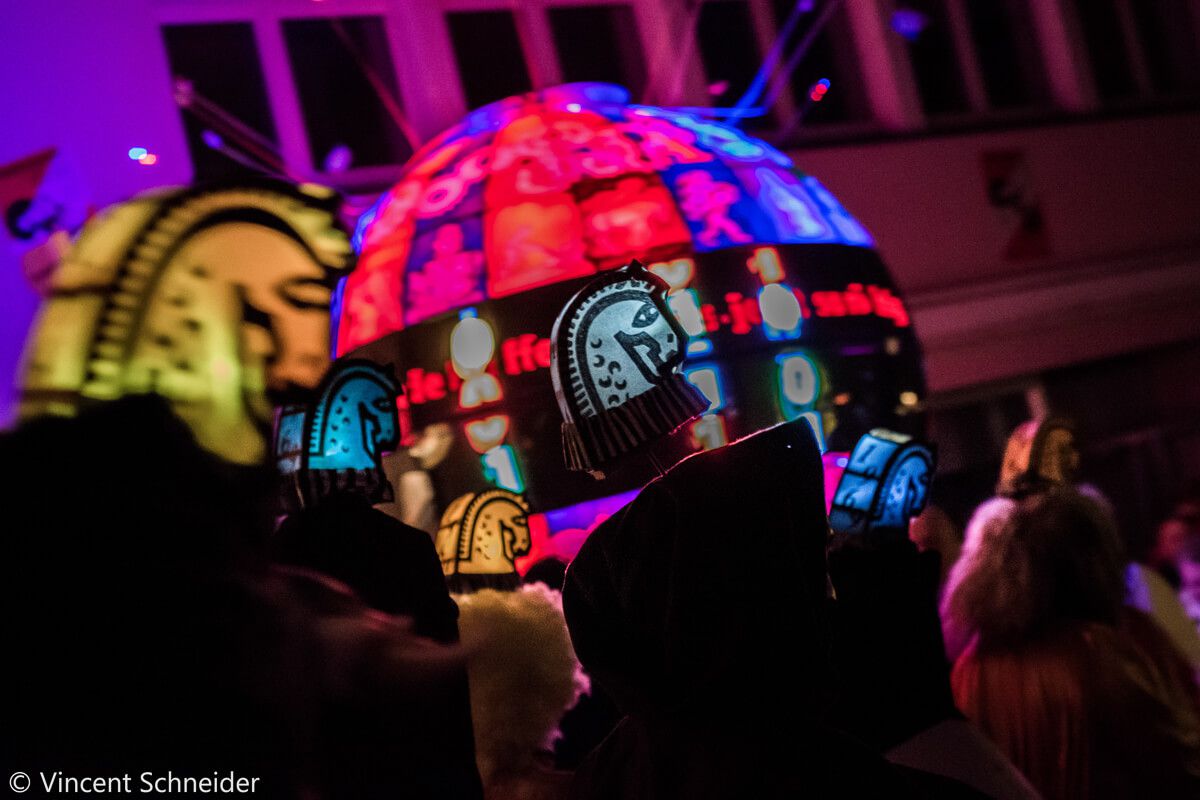


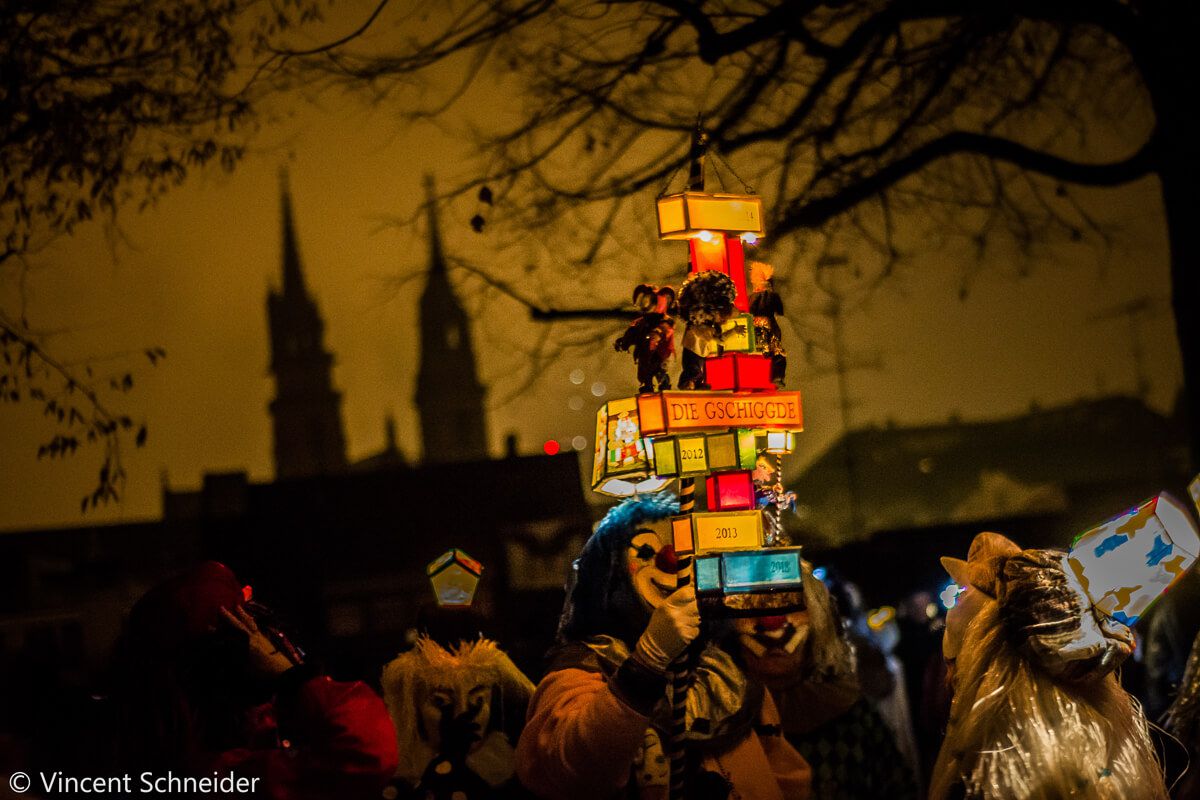
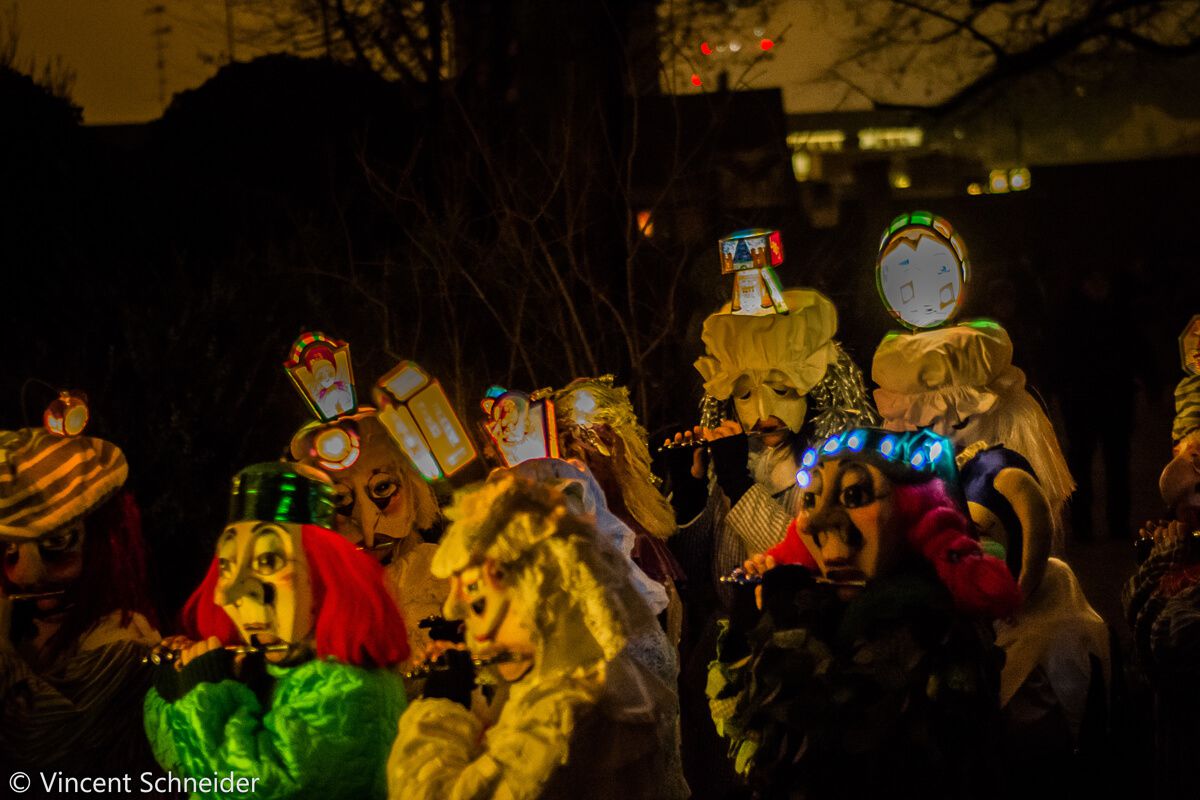
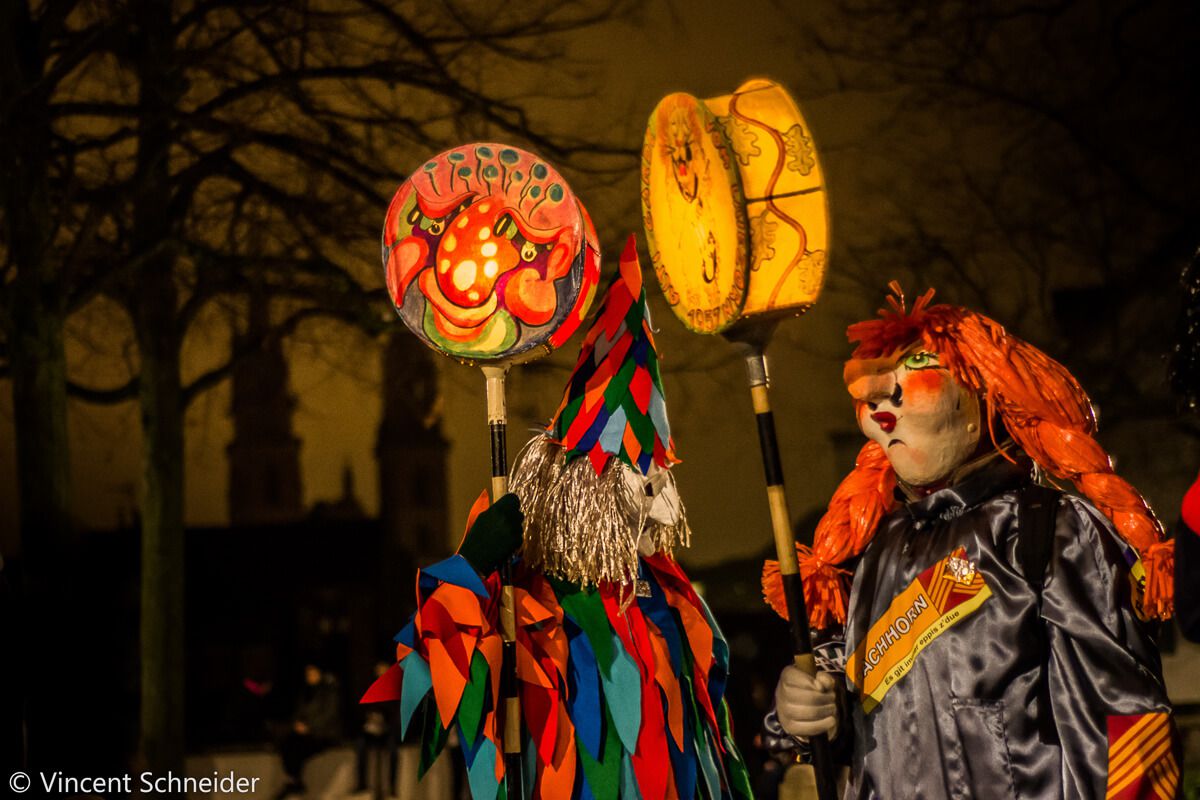
Practical information
Rates
The Basel carnival is free. However, you can support the organization by buying a badge (about 8 CHF for the cheapest one).
Program
Here you will find all the information you need about the carnival, its history and its program.
Access
By car
It is really not recommended: parking is already not easy in normal times but here it will be mission impossible… If you want to, I advise you to park in Saint-Louis (French border town) and then come by streetcar. Many streets in Basel are closed during the carnival.You can park at the border stadium in St. Louis, which is a 5-minute walk from the streetcar stop “St. Louis Grenze” in Switzerland. You can then take streetcar 11 to the Marktplatz stop (5/10 minutes) for example.Basel is located in:- 36 km from Mulhouse (about 30 minutes)
- 64 km from Colmar (about 45 minutes)
- 136 km from Strasbourg (about 1h20)
By public transport
The city center is only a 10/15 minute walk from the Basel train station or accessible by streetcar. From Alsace, there are special trains to the carnival (including the Morgenstreich!). You can look on Voyages SNCF.
Carnival of Kehl (Germany)

Narri, Narro. This cry from the procession and echoed by the crowd announces the Kehl carnival. The neighboring city of Strasbourg is transformed for a weekend in the purest tradition of the fastnacht from across the Rhine. I take you to discover this popular festival that sees witches and monsters parade to chase away winter.
A Carnival weekend in Kehl
In Kehl, Carnival takes place during a whole weekend. The festival starts on Saturday at 11:11 am with the Narrendorferöffnungor the opening of the crazy village, followed in the afternoon by activities for children until Nachtumzug at 18:11, the night parade where the light procession wanders through the center of Kehl.
The carnival festivities continue on Sunday morning with the reception at the city hall. Then from 13:31 the big parade takes place, the Großer Umzugwhich I attended with my family. The entrance is charged with several checkpoints along the main street (Hauptstrasse) where the parade will take place. I am pleasantly surprised by the atmosphere in the streets with children dressed up but also grown-ups. We feel that it is a real popular festival here.
A parade of witches, monsters and floats
At 1:31 pm, the procession starts and ends at the market place(Marktplatz). Witches and monsters march in to chase away winter with their rattles. The costumes are very colorful. They alternate with the delirious floats with their screaming sound system and the village bands with their trumpets, drums and percussion. The parade will last nearly 2 hours in total with a hundred troops. The atmosphere is very good, with traditional German music and a shower of candy and confetti.
The festival can be prolonged on the market place where many stands with refreshments or confectionery await you. The city’s businesses are also open. In the end, the Kehl Carnival is probably less impressive than the Basel or Cologne carnivals, but I find it much more fun and lively than the Strasbourg carnival.
I liked
- The streets of Kehl come alive and the atmosphere is very festive and family oriented
- Kids have fun and leave with lots of candy
- It’s easy to access for the citizens of Strasbourg
I liked less
- A hundred troops is a long time! After a while, we get a little tired of seeing witches
- The sound system of the floats is really loud
My photos of the Kehl carnival

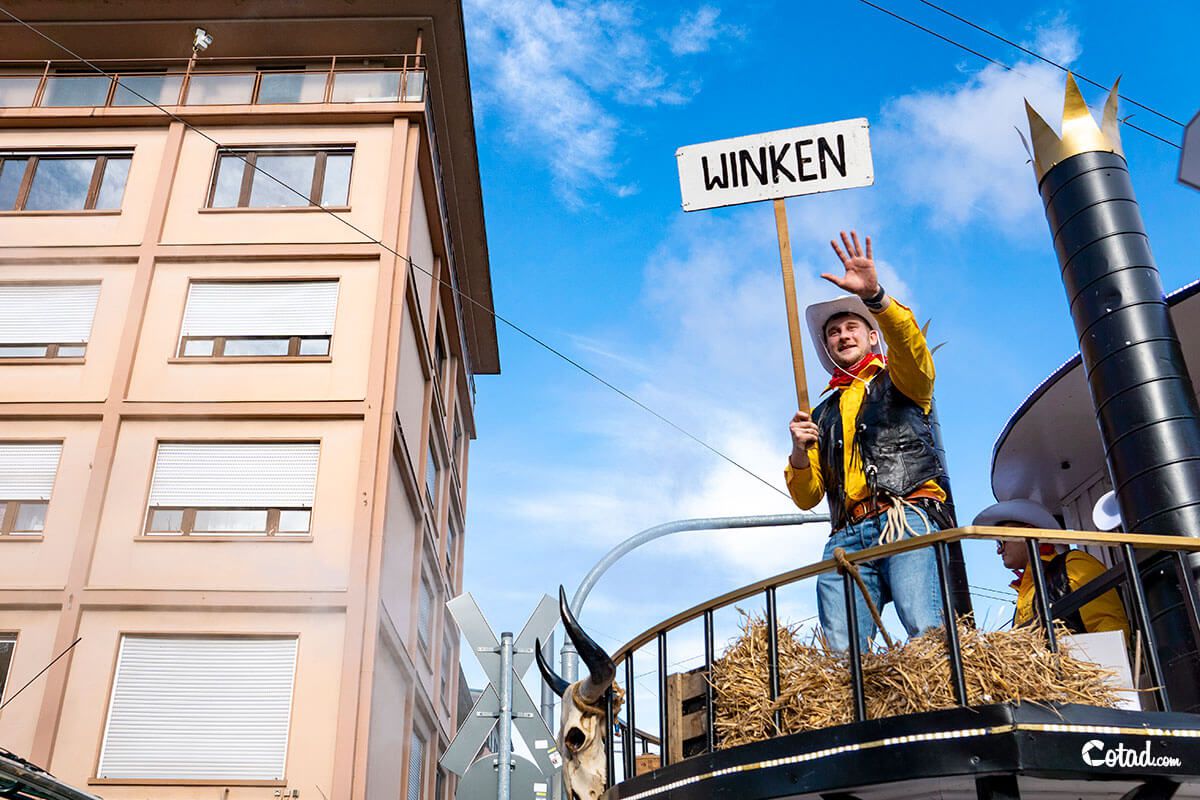
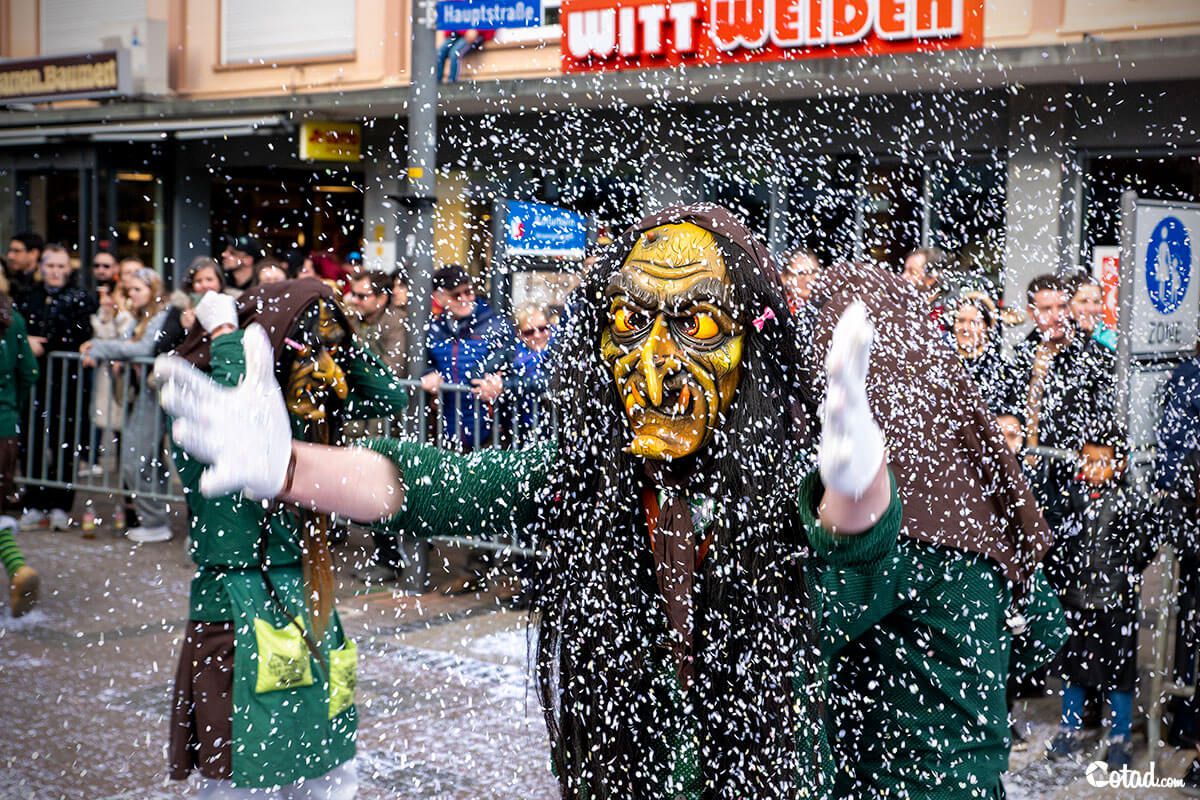
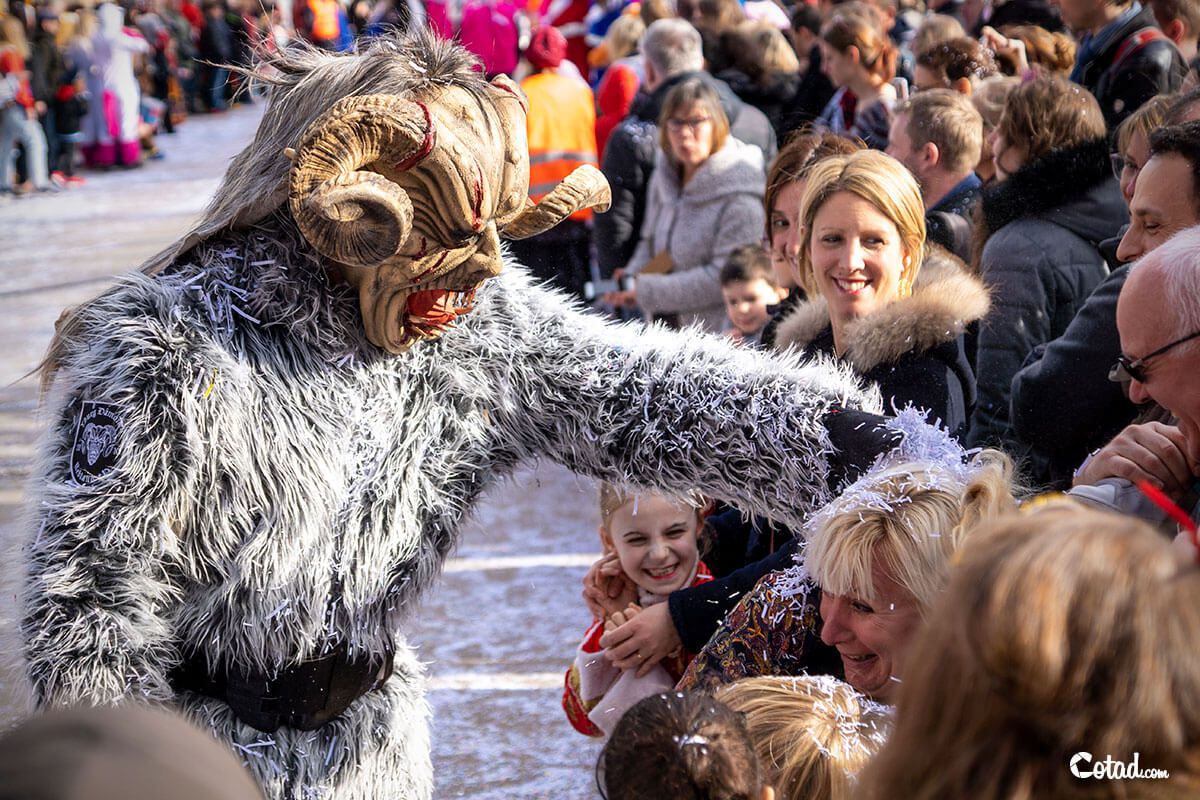
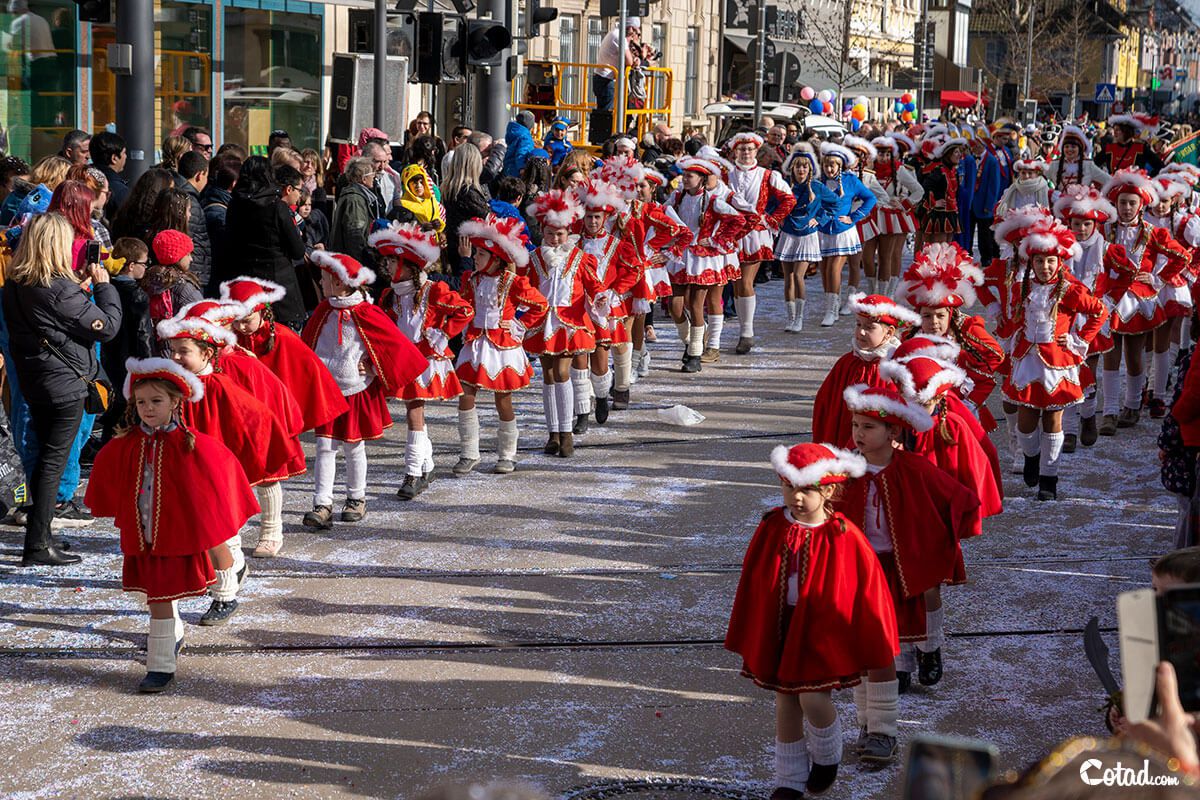
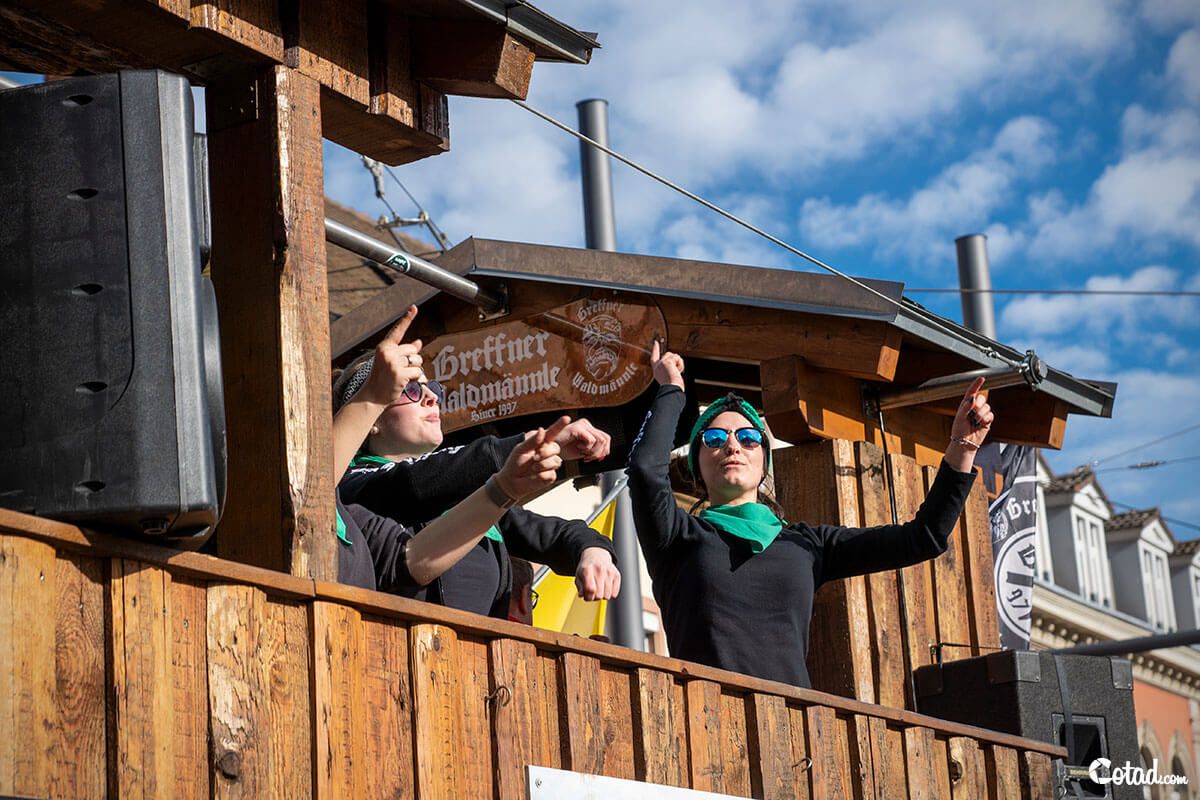
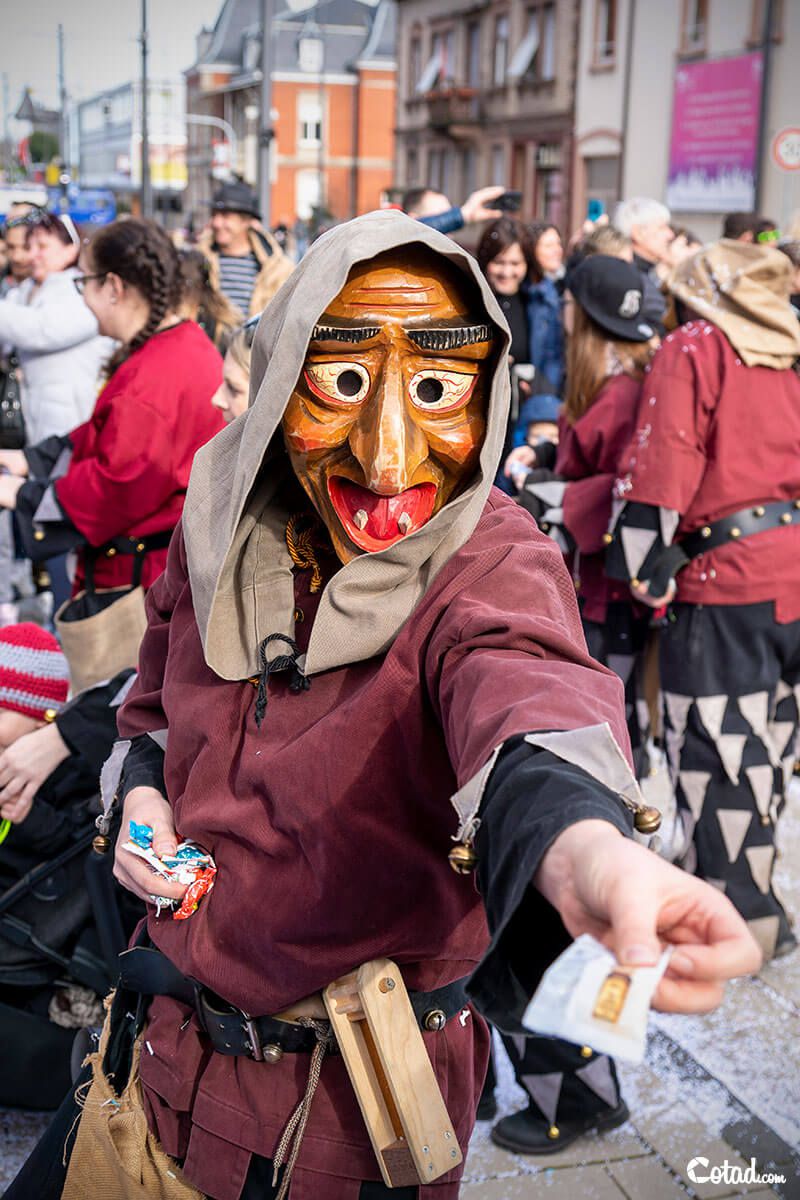


Practical information
Rates
The entrance to the carnival is not free: 3,50€ for adults from 16 years old. It’s free for the kids.
Date
The carnival usually takes place in February, a little before Mardi Gras, during a whole weekend.
Access
The parade takes place in the Hauptstrasse of Kehl.
By car
Free parking is available at the Kehl train station. It is necessary to count:- a few minutes from Strasbourg, just cross the Rhine!
- 79 kms from Colmar (about 1h)
- 127 kms from Mulhouse (about 1h15)

